Our First Pastor - Fr. Joseph Nussbaum
As you may know, St. Joe’s has a long history dating back to 1867 when Bishop Henni gave permission for the Germans to build their own church. It was finally dedicated on Dec 13, 1868 by Bishop Melcher, the first Bishop of the Green Bay Diocese.
Over the next couple of months, we’d like to go over our history, particularly by introducing Pastors who have served us at St. Joe’s. Perhaps it will help us appreciate the dedication and generosity of those who were here before us.
Our first official Pastor was Fr. Joseph Nussbaum. He arrived here on Feb 26, 1868 from Paderborn, Germany at the age of thirty-six (ordained ten years earlier). He was our Pastor for just one year. It is said he was a “straight forward and outspoken man”. Upon his arrival, Fr. Nussbaum found nothing to boast of in the physical assets of the parish. The church was a patched-up frame building standing on a tongue of land that projected into a ravine. There was no rectory. His first step was to convoke a meeting of parishioners to decide whether to build a new church or rectory. By a vote of 40-1 the decision was to build a rectory.
After much discussion, it was decided to build a rectory twenty-eight by twenty, with a height of eighteen feet for $330. The parish would provide the materials and prepare the foundation. (What can be built for $330 today?)
Fr. Nussbaum also helped begin St. Joseph’s own school. A room was arranged beneath the sanctuary of the church. The room would be thirty-six feet long with plenty of light and air. The renovation cost was $220! Fr. Nussbaum was, for the most part, the one and only teacher. For all of its limitations St. Joe’s had its own school. Fr. Nussbaum left his mark at St. Joe’s and was transferred to Green Bay on Feb 22, 1870.
Over the next couple of months, we’d like to go over our history, particularly by introducing Pastors who have served us at St. Joe’s. Perhaps it will help us appreciate the dedication and generosity of those who were here before us.
Our first official Pastor was Fr. Joseph Nussbaum. He arrived here on Feb 26, 1868 from Paderborn, Germany at the age of thirty-six (ordained ten years earlier). He was our Pastor for just one year. It is said he was a “straight forward and outspoken man”. Upon his arrival, Fr. Nussbaum found nothing to boast of in the physical assets of the parish. The church was a patched-up frame building standing on a tongue of land that projected into a ravine. There was no rectory. His first step was to convoke a meeting of parishioners to decide whether to build a new church or rectory. By a vote of 40-1 the decision was to build a rectory.
After much discussion, it was decided to build a rectory twenty-eight by twenty, with a height of eighteen feet for $330. The parish would provide the materials and prepare the foundation. (What can be built for $330 today?)
Fr. Nussbaum also helped begin St. Joseph’s own school. A room was arranged beneath the sanctuary of the church. The room would be thirty-six feet long with plenty of light and air. The renovation cost was $220! Fr. Nussbaum was, for the most part, the one and only teacher. For all of its limitations St. Joe’s had its own school. Fr. Nussbaum left his mark at St. Joe’s and was transferred to Green Bay on Feb 22, 1870.
Past Pastor # 2 - Fr. Ferdinand Stern
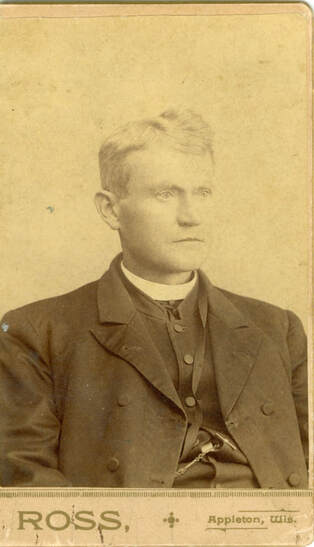 Fr. Ferdinand Stern
Fr. Ferdinand Stern
In last week’s bulletin we began telling the story of “Past Pastors of St Joe’s”. We hope in reviewing those who have served our parish over the past 147 years, we will gain an appreciation for the long history of this parish. Last week we introduced Fr. Joseph Nussbaum who was our first Pastor. He was only here for one year and then was replaced by Fr. Ferdinand Stern. He served the parish for seven years! The fact that he was here for seven years is short of a miracle! His Pastorate was characterized by turmoil, arguing, disagreeing, and finally his resigning from the parish.
Fr. Stern was 29 when he arrived in Appleton from his birthplace in Austria. Because of his temper, he encountered many difficulties in addressing the needs of the parish. His first order of business was to establish rules concerning membership in the parish. There seems to have been a great laxity in this regard, and Fr. Stern insisted on order! (Some agreed with his approach, but many did not.)
His next task was in regards to the school. Within a month after arriving here, he got two Sisters of St. Agnes to come and teach. The “German Catholic School” had 90 students. English was taught in the morning and German in the afternoon. For some unknown reason in July, 1873 the sisters were told to return to their motherhouse. Fortunately, the School Sisters of Notre Dame were willing to come and teach the children.
Other troubles that faced Fr. Stern: In 1871, a fire occurred in the rectory. Fortunately it was quickly extinguished and the damage, amounting to $7, was paid by the insurance company. Fr. Stern wanted to have a lightning-rod installed on the rectory, but his request was voted down at a parish meeting. However, he realized that a pastor could incur expenses up to $30 without consulting the parish; and the rod was installed. When Fr. Stern wanted a sidewalk built from the church to the street, it was refused unless he himself would collect the money. It took a while, but he finally got the money.
The biggest headache was the building of a new church. In 1871 the parish decided to replace the ramshackle building that had been called a church. It was dedicated on Nov, 1872 and is essentially the same structure we have today. It cost $21,140. That’s where the headache began. Parishioners contributed $10,000 leaving a loan of $11,000. On account of subsequent events, this debt soon became a nightmare.
Besides paying off the loan, a new school needed to be built. A scheme was devised to quickly raise a lot of money. The parish would hold a national lottery with 30,000 ticketsto be sold at a dollar apiece. $12,000 would be given in prizes resulting in $18,000 profit. Well, tickets were sent all over the country. However, soon after that the U.S. Congress passed a law forbidding the use of mail for lottery purposes. A frantic appeal was made to the Postmaster General for an exception. It was denied! The end result of all the planning and hard work was a profit of less than $1,000. As such, this scheme was deemed a grand failure.
Fr. Stern knew he was faced with a mess. The parish was facing the real prospect of bankruptcy and had lost all confidence in their Pastor. Fr. Stern sent a letter of resignation on April 15, 1877 and left the parish.
Fr. Stern was 29 when he arrived in Appleton from his birthplace in Austria. Because of his temper, he encountered many difficulties in addressing the needs of the parish. His first order of business was to establish rules concerning membership in the parish. There seems to have been a great laxity in this regard, and Fr. Stern insisted on order! (Some agreed with his approach, but many did not.)
His next task was in regards to the school. Within a month after arriving here, he got two Sisters of St. Agnes to come and teach. The “German Catholic School” had 90 students. English was taught in the morning and German in the afternoon. For some unknown reason in July, 1873 the sisters were told to return to their motherhouse. Fortunately, the School Sisters of Notre Dame were willing to come and teach the children.
Other troubles that faced Fr. Stern: In 1871, a fire occurred in the rectory. Fortunately it was quickly extinguished and the damage, amounting to $7, was paid by the insurance company. Fr. Stern wanted to have a lightning-rod installed on the rectory, but his request was voted down at a parish meeting. However, he realized that a pastor could incur expenses up to $30 without consulting the parish; and the rod was installed. When Fr. Stern wanted a sidewalk built from the church to the street, it was refused unless he himself would collect the money. It took a while, but he finally got the money.
The biggest headache was the building of a new church. In 1871 the parish decided to replace the ramshackle building that had been called a church. It was dedicated on Nov, 1872 and is essentially the same structure we have today. It cost $21,140. That’s where the headache began. Parishioners contributed $10,000 leaving a loan of $11,000. On account of subsequent events, this debt soon became a nightmare.
Besides paying off the loan, a new school needed to be built. A scheme was devised to quickly raise a lot of money. The parish would hold a national lottery with 30,000 ticketsto be sold at a dollar apiece. $12,000 would be given in prizes resulting in $18,000 profit. Well, tickets were sent all over the country. However, soon after that the U.S. Congress passed a law forbidding the use of mail for lottery purposes. A frantic appeal was made to the Postmaster General for an exception. It was denied! The end result of all the planning and hard work was a profit of less than $1,000. As such, this scheme was deemed a grand failure.
Fr. Stern knew he was faced with a mess. The parish was facing the real prospect of bankruptcy and had lost all confidence in their Pastor. Fr. Stern sent a letter of resignation on April 15, 1877 and left the parish.
Past Pastor #3 - Fr. Didacus Wendel
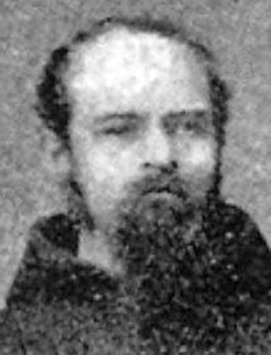 Fr. Didacus Wendel
Fr. Didacus Wendel
Last week’s bulletin spoke of the turbulent times during Fr. Ferdinand Stern’s 7 years at St Joe’s. Attempting to bring stability and greater harmony to the parish, Bp. Krautbauer begged the Capuchins to help him by taking over the parish.
In 1877, Fr. Didacus Wendel became the first of many Capuchin Pastors. The parish numbered 357 members at that time. The parish debt was $12,256. Fr. Didacus decided his first duty was to ease the financial burdens. He proposed a grand picnic for July 4. He got parishioners to donate items for a bazaar, which raised $656…a great accomplishment at the time. The parishioners felt at once that he had their welfare at heart and they rallied to the support of their bearded and sandaled pastor in the brown habit.
A few months after Fr. Didacus became Pastor, Fr. Vincent Heinekamp was assigned as an Associate Pastor. The two of them worked hard to bring back those who had become estranged from the Church. Fr. Didacus focused on the financial issues and Fr. Vincent worked on bringing about a better religious spirit.
The school was a constant concern. 150 children made up the school in 1877. More space was need than was available so two store rooms were rented on the north side of College Avenue, a few doors east of State Street. As the enrollment increased, it was apparent that a new school had to be built. In 1879, plans were developed and foundations dug. However, the plans were considered inadequate by the Capuchin superiors and the project was put on hold.
Another issue was the desire to have a cemetery of their own. Up till now the parish shared a cemetery with St. Mary’s. Rather than settle the squabbling over the shared cemetery, twenty acres were purchased on the banks of the Fox River, east of the city for the sum of $1,000. On Dec 1, 1878, Bp. Krautbauer solemnly dedicated the cemetery to St. Joseph.
On July 17, 1879, Fr. Didacus was unexpectedly recalled to Mt. Calvary by his superiors. There are reasons to believe they feared he was losing his vocation to religious life. Tho’ he left abruptly, it’s important to remember that during his Pastorate he reduced the debt by $4,500. Upon his arrival the parish was torn with dissension and discouragement; when he left, the spirit of the parish had radically changed and its members were looking to the future with confidence.
In 1877, Fr. Didacus Wendel became the first of many Capuchin Pastors. The parish numbered 357 members at that time. The parish debt was $12,256. Fr. Didacus decided his first duty was to ease the financial burdens. He proposed a grand picnic for July 4. He got parishioners to donate items for a bazaar, which raised $656…a great accomplishment at the time. The parishioners felt at once that he had their welfare at heart and they rallied to the support of their bearded and sandaled pastor in the brown habit.
A few months after Fr. Didacus became Pastor, Fr. Vincent Heinekamp was assigned as an Associate Pastor. The two of them worked hard to bring back those who had become estranged from the Church. Fr. Didacus focused on the financial issues and Fr. Vincent worked on bringing about a better religious spirit.
The school was a constant concern. 150 children made up the school in 1877. More space was need than was available so two store rooms were rented on the north side of College Avenue, a few doors east of State Street. As the enrollment increased, it was apparent that a new school had to be built. In 1879, plans were developed and foundations dug. However, the plans were considered inadequate by the Capuchin superiors and the project was put on hold.
Another issue was the desire to have a cemetery of their own. Up till now the parish shared a cemetery with St. Mary’s. Rather than settle the squabbling over the shared cemetery, twenty acres were purchased on the banks of the Fox River, east of the city for the sum of $1,000. On Dec 1, 1878, Bp. Krautbauer solemnly dedicated the cemetery to St. Joseph.
On July 17, 1879, Fr. Didacus was unexpectedly recalled to Mt. Calvary by his superiors. There are reasons to believe they feared he was losing his vocation to religious life. Tho’ he left abruptly, it’s important to remember that during his Pastorate he reduced the debt by $4,500. Upon his arrival the parish was torn with dissension and discouragement; when he left, the spirit of the parish had radically changed and its members were looking to the future with confidence.
Past Pastor # 4 - Fr. Bonaventure Frey (1879-1882)
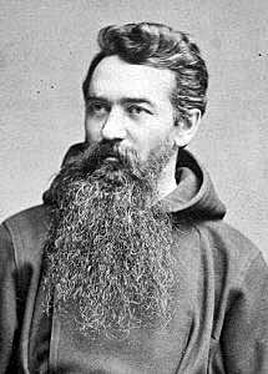 Fr. Bonaventure Frey
Fr. Bonaventure Frey
Our fourth Pastor was Fr. Bonaventure Frey (1879-1882), one of the co-founders of establishing the Capuchin Order at Mt. Calvary, WI. What an impressive man! In 1879, he was elected the head of the Capuchins in Wisconsin and New York. Since there was no “headquarters” established yet, he chose Appleton as his residence and assumed being Pastor here. Thankfully, Fr. Pacificus Berlemann was his associate and carried on the parish work whenever he was called away from the parish with his other job.
Again, the school was the first task for Fr. Bonaventure. Fr. Didacus’ plans had been rejected by his superiors. But Fr. Bonaventure used some of them to plan and construct an even bigger building. Contracts were let for $22,000. He gave his personal attention to the building, demanding that everything be carried out according to specs. It is said that he climbed among the scaffolding as the work progressed and that, at least on one occasion, he had a large part of the work torn out because details had not been adhered to exactly. The result was a solid building.
The new school was 81 x 92 feet, showing three stories on the north and two stories on the other sides. There were numerous classrooms for boys and girls; apartments for the Sisters, and an exhibition hall on the second floor. It was dedicated on Nov, 1880. A bazaar was held in connections with the dedication, netting $3,000. It was a clear sign that the parishioners were enthusiastic about their new school. At this time there were five Sisters and a layman, Engelbert Schueller teaching well over 200 students.
Another matter needing attention was the friary. It originally was built for one priest, but now there were three priests and two brothers…far too cramped to be a friary. The lean-to kitchen was torn down and another wing built in its place. These new accommodations served their purpose for ten more years.
In 1882, Fr. Bonaventure was re-elected to be the leader of the Capuchins. He needed to take residence in Detroit so he could no longer be our Pastor. He certainly left his mark on the parish. The parish now had a full parish plant, church, school, friary, convent and a cemetery of their own. Their courage had revived and a deep foundation of spirituality had been laid.
Again, the school was the first task for Fr. Bonaventure. Fr. Didacus’ plans had been rejected by his superiors. But Fr. Bonaventure used some of them to plan and construct an even bigger building. Contracts were let for $22,000. He gave his personal attention to the building, demanding that everything be carried out according to specs. It is said that he climbed among the scaffolding as the work progressed and that, at least on one occasion, he had a large part of the work torn out because details had not been adhered to exactly. The result was a solid building.
The new school was 81 x 92 feet, showing three stories on the north and two stories on the other sides. There were numerous classrooms for boys and girls; apartments for the Sisters, and an exhibition hall on the second floor. It was dedicated on Nov, 1880. A bazaar was held in connections with the dedication, netting $3,000. It was a clear sign that the parishioners were enthusiastic about their new school. At this time there were five Sisters and a layman, Engelbert Schueller teaching well over 200 students.
Another matter needing attention was the friary. It originally was built for one priest, but now there were three priests and two brothers…far too cramped to be a friary. The lean-to kitchen was torn down and another wing built in its place. These new accommodations served their purpose for ten more years.
In 1882, Fr. Bonaventure was re-elected to be the leader of the Capuchins. He needed to take residence in Detroit so he could no longer be our Pastor. He certainly left his mark on the parish. The parish now had a full parish plant, church, school, friary, convent and a cemetery of their own. Their courage had revived and a deep foundation of spirituality had been laid.
Past Pastor #5 - Fr. Francis Haas (1882-1885)
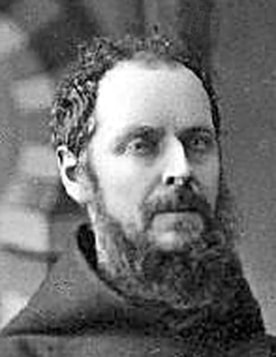 Fr. Francis Haas
Fr. Francis Haas
The successor of Fr. Bonaventure was Fr. Francis Haas (1882-1885), the co-founder of establishing the Capuchins in the United States. While Fr. Bonaventure was mostly interested in the material improvements of the parish, Fr. Francis gave most of his attention to its spiritual progress. One of his first achievements was to replace the old melodeon (organ) that was too small for the large church. The Schaefer Company (Slinger, WI) built and installed the organ for $3,000. It was the best that could then be built and served the parish for many years.
Fr. Francis also left a lasting mark when he initiated the Third Order of St. Francis here at St. Joe’s. It offered laypeople the opportunity to live a life after the example of St. Francis of Assisi. This lay group continues to exist in the parish to this very day.
Different organizations were established at St. Joe’s during Fr. Francis’ pastorate. Among them were: the Sodality of our Lady, the St. Joseph Society, and The Catholic Knights of Wisconsin. They provided opportunities for socializing and contributing to the needs of the parish.
In this period a plan was gaining momentum to establish a third parish in Appleton. It was to comprise the territory south of the river, and then called the fourth ward. The idea was favored because the old people and the children found it rather difficult to walk the long way to church over the decrepit bridge. Members would be taken mostly from St. Joe’s, although St. Mary’s Parish would also lose some parishioners.
A plot of land was donated two blocks east of the present Sacred Heart Church. The building structure must have been makeshift, for when the roof was being shingled a heavy windstorm tore down the building and made it a mass of debris. The new parishioners found this blow too heavy for them to carry. The project of a new church was abandoned and would not be resumed till the end of the century.
Fr. Francis also left a lasting mark when he initiated the Third Order of St. Francis here at St. Joe’s. It offered laypeople the opportunity to live a life after the example of St. Francis of Assisi. This lay group continues to exist in the parish to this very day.
Different organizations were established at St. Joe’s during Fr. Francis’ pastorate. Among them were: the Sodality of our Lady, the St. Joseph Society, and The Catholic Knights of Wisconsin. They provided opportunities for socializing and contributing to the needs of the parish.
In this period a plan was gaining momentum to establish a third parish in Appleton. It was to comprise the territory south of the river, and then called the fourth ward. The idea was favored because the old people and the children found it rather difficult to walk the long way to church over the decrepit bridge. Members would be taken mostly from St. Joe’s, although St. Mary’s Parish would also lose some parishioners.
A plot of land was donated two blocks east of the present Sacred Heart Church. The building structure must have been makeshift, for when the roof was being shingled a heavy windstorm tore down the building and made it a mass of debris. The new parishioners found this blow too heavy for them to carry. The project of a new church was abandoned and would not be resumed till the end of the century.
Past Pastor #6 - Fr. Bernadine Schmitz (1885-1888)
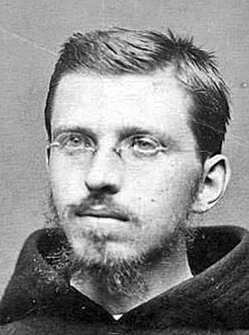 Fr. Bernadine Schmitz
Fr. Bernadine Schmitz
Our sixth Pastor was Fr. Bernadine Schmitz (1885-1888). Like his predecessor, Fr. Francis Haas, he emphasized the spiritual advancement of the parish and caring for the beauty of the house of God. He gave a lot of his attention to the societies of the parish.
Although the parish had societies for married men and ladies, as well as the young men and ladies, there was no society for the boys and girls who had left school. To help this age group Fr. Bernadine founded the St. Stanislaus and St. Rose societies. They were made up of boys and girls who had received their first Holy Communion (age 12), but who were not yet old enough to join one of the other societies. They were a neglected group, for at that time many children ended their schooling immediately after receiving first Holy Communion and were no longer under the control of the pastor. Many were employed in the mills where they faced many bad influences.
Fr. Bernadine also introduced the Archconfraternity of the Sacred Heart to the parish. He expected this devotion to become the high point of new religious fervor. A statue of the Sacred Heart was obtained and also one of the Immaculate Heart of Mary. They were placed prominently in the sanctuary. Undoubtedly this devotion contributed much to strengthen the good will and spirit that has prevailed in the parish.
During Fr. Bernadine’s term, Bishop Francis Krautbauer died and was succeeded by Bishop Francis Katzer. It wasn’t long after that, Fr. Bernadine’s time as Pastor had come to an end. Who would be the next Capuchin Pastor?
Although the parish had societies for married men and ladies, as well as the young men and ladies, there was no society for the boys and girls who had left school. To help this age group Fr. Bernadine founded the St. Stanislaus and St. Rose societies. They were made up of boys and girls who had received their first Holy Communion (age 12), but who were not yet old enough to join one of the other societies. They were a neglected group, for at that time many children ended their schooling immediately after receiving first Holy Communion and were no longer under the control of the pastor. Many were employed in the mills where they faced many bad influences.
Fr. Bernadine also introduced the Archconfraternity of the Sacred Heart to the parish. He expected this devotion to become the high point of new religious fervor. A statue of the Sacred Heart was obtained and also one of the Immaculate Heart of Mary. They were placed prominently in the sanctuary. Undoubtedly this devotion contributed much to strengthen the good will and spirit that has prevailed in the parish.
During Fr. Bernadine’s term, Bishop Francis Krautbauer died and was succeeded by Bishop Francis Katzer. It wasn’t long after that, Fr. Bernadine’s time as Pastor had come to an end. Who would be the next Capuchin Pastor?
Past Pastor #7 - Fr. Pacificus Berlemann (1888-1889)
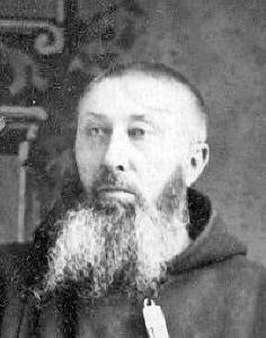 Fr. Pacificus Berlemann
Fr. Pacificus Berlemann
Fr. Francis Haas and Fr. Bernadine Schmitz had both tried to focus on the spiritual growth of the parish.
Our next Pastor, Fr. Pacificus Berlemann (1888-1889) began a six year period of building activity. He was sixty years old when he arrived at St Joe’s and, realizing the church building needed to be enlarged, hired an architect to submit sketches for renovating the church. It was dramatically enhanced with a large transept and roomy sanctuary, giving a cruciform shape to the church. The whole ceiling was rebuilt according to the gothic style with its pointed arches. Two rows of pillars had to be installed in order to vault the ceiling. Slate shingles replaced the wooden ones on the roof. New pews were installed. When completed the church presented a striking appearance in its gothic style, drawing the mind and heart up to God by the pointed arches that aspire to heaven. This construction began in March 1889 and was completed eight months later to the tune of $25,112.
Unfortunately Fr. Pacificus was not able to see its completion. He died of cancer October 11, 1889. He was deeply mourned by the parishioners who had come to love and respect this pastor. Fr. Pacificus was immediately replaced by Fr. Lawrence Henn, who would have two separate appointments as Pastor of St. Joe’s.
Our next Pastor, Fr. Pacificus Berlemann (1888-1889) began a six year period of building activity. He was sixty years old when he arrived at St Joe’s and, realizing the church building needed to be enlarged, hired an architect to submit sketches for renovating the church. It was dramatically enhanced with a large transept and roomy sanctuary, giving a cruciform shape to the church. The whole ceiling was rebuilt according to the gothic style with its pointed arches. Two rows of pillars had to be installed in order to vault the ceiling. Slate shingles replaced the wooden ones on the roof. New pews were installed. When completed the church presented a striking appearance in its gothic style, drawing the mind and heart up to God by the pointed arches that aspire to heaven. This construction began in March 1889 and was completed eight months later to the tune of $25,112.
Unfortunately Fr. Pacificus was not able to see its completion. He died of cancer October 11, 1889. He was deeply mourned by the parishioners who had come to love and respect this pastor. Fr. Pacificus was immediately replaced by Fr. Lawrence Henn, who would have two separate appointments as Pastor of St. Joe’s.
Past Pastor #8 - Fr. Lawrence Henn (1889-1891)
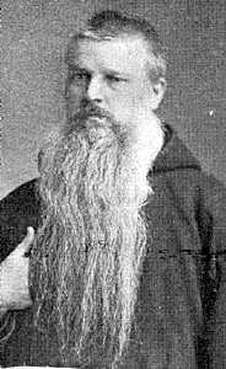 Fr. Lawrence Henn
Fr. Lawrence Henn
Due to the sudden death of Fr Pacificus, Fr Lawrence Henn (1889-1891) was abruptly pulled from teaching at Mt Calvary to become our pastor for two years. He didn’t stay long, but would return ten years later and stay for almost a decade.
Fr Lawrence left Mt Calvary with a heavy heart for he loved teaching and was held in high regard by his students. They showed their attachment when, at his departure, their band played a funeral march. After a year here at St Joe’s, he wrote to his Provincial: “Here at Appleton there is a father who was a professor at Mt Calvary last year. He would like to return if he could.”
Despite his feelings, Fr Lawrence put his whole heart into his duties as Pastor. The church building was almost complete but many details remained unfinished. Finally the new church was dedicated by Bp Katzer on Nov 24, 1889.
Special attention also had to be given to the grounds back of the church and friary because they were moving down the ravine. An extensive barrier of logs and rocks was built to save the grounds and buildings.
At this time another generous expense was assumed by the parish, when the bishop declared the school “free”, that is, tuition would no longer be charged. All parishioners could now send their children to the school for “free”. This arrangement lifted a heavy burden from large families and distributed it more equitably among the parishioners.
In early 1890 there was a crying need for a new friary. The first rectory was built for one person. An additional wing had been built but still did not suffice for all the needs of a friary. At the annual parish meeting the parishioners voted to build a new friary, paid for entirely by the parish. It would cost $16,000. Even tho the parish offered to pay the entire cost, the Capuchin provincial superiors offered to pay half for which the parish was very grateful. By the fall of 1890 the friary was built and the Capuchins were able to move in.
In spite of not wanting to become Pastor of St Joe’s, Fr Lawrence made significant accomplishment in his two short years here. He finished the construction of the church and got a new friary built.
Fr Lawrence left Mt Calvary with a heavy heart for he loved teaching and was held in high regard by his students. They showed their attachment when, at his departure, their band played a funeral march. After a year here at St Joe’s, he wrote to his Provincial: “Here at Appleton there is a father who was a professor at Mt Calvary last year. He would like to return if he could.”
Despite his feelings, Fr Lawrence put his whole heart into his duties as Pastor. The church building was almost complete but many details remained unfinished. Finally the new church was dedicated by Bp Katzer on Nov 24, 1889.
Special attention also had to be given to the grounds back of the church and friary because they were moving down the ravine. An extensive barrier of logs and rocks was built to save the grounds and buildings.
At this time another generous expense was assumed by the parish, when the bishop declared the school “free”, that is, tuition would no longer be charged. All parishioners could now send their children to the school for “free”. This arrangement lifted a heavy burden from large families and distributed it more equitably among the parishioners.
In early 1890 there was a crying need for a new friary. The first rectory was built for one person. An additional wing had been built but still did not suffice for all the needs of a friary. At the annual parish meeting the parishioners voted to build a new friary, paid for entirely by the parish. It would cost $16,000. Even tho the parish offered to pay the entire cost, the Capuchin provincial superiors offered to pay half for which the parish was very grateful. By the fall of 1890 the friary was built and the Capuchins were able to move in.
In spite of not wanting to become Pastor of St Joe’s, Fr Lawrence made significant accomplishment in his two short years here. He finished the construction of the church and got a new friary built.
Past Pastor #9 - Fr. Honoratus Schmidt (1891-1894)
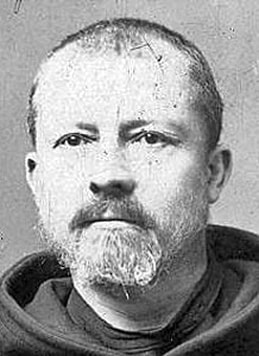 Fr. Honoratus Schmidt
Fr. Honoratus Schmidt
Fr Honoratus Schmidt (1891-1894) became our ninth Pastor. (A reminder is in order here. All of our Capuchin pastors were “true blue” Germans. As was the case with his predecessors, Fr Honoratus was born in Germany…Baden to be specific…and came to this country where he became a Capuchin.)
His appointment at this time seems ironical, for his interest lay especially in the spiritual welfare of the parish and in the return of lapsed Catholics. However, most of his time was taken with plans for a hall. Upon his arrival, parishioners demanded that a hall be built. As he himself wrote early the next year, “I would gladly have left everything as it was; but this is no longer possible. The societies have no place for their meetings, the school has become too small, the young men want a casino etc.”
There was no quick decision on how and what kind of hall to build. The parish was carrying a $14,000 debt and the country experienced the panic of 1893 to make money matters worse. However, the need for a hall was intensified with a continued shortage of space in the school, whose enrollment had risen to 600 students. This issue could be dealt with if the current hall were converted into classrooms.
Although some in the parish were opposed to entering an expensive building program, the proponents remained firm in their conviction that something had to be done. By May, 1894, Fr Honoratus reported that “as far as I can judge, everyone is now satisfied with the construction of the hall.”
One of the sad moments of Fr Honoratus’ Pastorate was the death of Sr Januaria, a Notre Dame nun, who was just 38 years old. She had endeared herself to the school children and parishioners since being made Superioress in 1889. She would be succeeded by Sr Ernestine as Superioress for the next 26 years! With the arrival of the Notre Dame Sisters, our school enrollment increased from 200 to 600 students. A tribute to the excellent teaching in school.
On Oct 18, 1993 the parish celebrated its silver anniversary of the first Mass in the old church. The parish was rightfully proud of its achievements. There had been some hectic days, but the spirit of the parishioners had remained uniformly good. Whatever troubles were overcome made the parish that much stronger and determined.
His appointment at this time seems ironical, for his interest lay especially in the spiritual welfare of the parish and in the return of lapsed Catholics. However, most of his time was taken with plans for a hall. Upon his arrival, parishioners demanded that a hall be built. As he himself wrote early the next year, “I would gladly have left everything as it was; but this is no longer possible. The societies have no place for their meetings, the school has become too small, the young men want a casino etc.”
There was no quick decision on how and what kind of hall to build. The parish was carrying a $14,000 debt and the country experienced the panic of 1893 to make money matters worse. However, the need for a hall was intensified with a continued shortage of space in the school, whose enrollment had risen to 600 students. This issue could be dealt with if the current hall were converted into classrooms.
Although some in the parish were opposed to entering an expensive building program, the proponents remained firm in their conviction that something had to be done. By May, 1894, Fr Honoratus reported that “as far as I can judge, everyone is now satisfied with the construction of the hall.”
One of the sad moments of Fr Honoratus’ Pastorate was the death of Sr Januaria, a Notre Dame nun, who was just 38 years old. She had endeared herself to the school children and parishioners since being made Superioress in 1889. She would be succeeded by Sr Ernestine as Superioress for the next 26 years! With the arrival of the Notre Dame Sisters, our school enrollment increased from 200 to 600 students. A tribute to the excellent teaching in school.
On Oct 18, 1993 the parish celebrated its silver anniversary of the first Mass in the old church. The parish was rightfully proud of its achievements. There had been some hectic days, but the spirit of the parishioners had remained uniformly good. Whatever troubles were overcome made the parish that much stronger and determined.
Past Pastor #10 - Fr. Timothy Grossman (1894-1897)
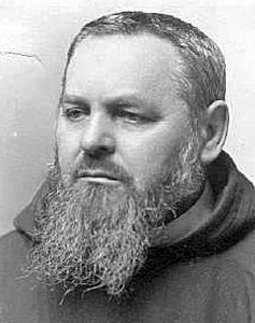 Fr. Timothy Grossman
Fr. Timothy Grossman
Fr. Timothy Grossman (1894-1897) also was bor in Germany and emigrated to America when he was about 26 years old. At the age of 51 he was appointed Pastor of St. Joe’s.
[Editor’s note: You probably have noticed that most of the Capuchin Pastors were here for only three years. That’s because their appointment coincided with the Chapter meeting held every three years by the Capuchins. New assignments were often given at that time. Unlike today, a Capuchin would receive an envelope with a letter informing him of where he was to work for the next three years. And you also can’t help but notice that these Capuchin Pastors all wore beards. Years ago Capuchins were not allowed to shave no matter how ungodly their beard looked. Obviously this Capuchin tradition is no longer in effect!]
Fr. Timothy’s cheerfulness and good spirit initiated a period of unification and harmony. During the previous six years the parish had spent about $35,000 in its building programs. The church hall was completed during Fr. Timothy’s time … leaving a debt of $19,133. The concerns over the debt were overshadowed by how happy the parishioners were with the hall. The social life of the parish grew and the societies had plenty of room for their meetings and parish events.
Another improvement that Fr. Timothy took on was getting better lighting in the church with the introduction of electric lighting. What did they have before that? This improvement was considered “progress” even tho’ it was so simple and fundamental that it would hardly be accepted in our day as adequate for a church. But something is often better than nothing, right?
[Editor’s note: You probably have noticed that most of the Capuchin Pastors were here for only three years. That’s because their appointment coincided with the Chapter meeting held every three years by the Capuchins. New assignments were often given at that time. Unlike today, a Capuchin would receive an envelope with a letter informing him of where he was to work for the next three years. And you also can’t help but notice that these Capuchin Pastors all wore beards. Years ago Capuchins were not allowed to shave no matter how ungodly their beard looked. Obviously this Capuchin tradition is no longer in effect!]
Fr. Timothy’s cheerfulness and good spirit initiated a period of unification and harmony. During the previous six years the parish had spent about $35,000 in its building programs. The church hall was completed during Fr. Timothy’s time … leaving a debt of $19,133. The concerns over the debt were overshadowed by how happy the parishioners were with the hall. The social life of the parish grew and the societies had plenty of room for their meetings and parish events.
Another improvement that Fr. Timothy took on was getting better lighting in the church with the introduction of electric lighting. What did they have before that? This improvement was considered “progress” even tho’ it was so simple and fundamental that it would hardly be accepted in our day as adequate for a church. But something is often better than nothing, right?
Past Pastor #11 - Fr. Ignatius Ullrich (1897-1900)
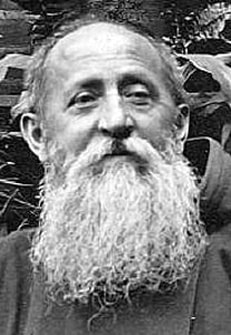 Fr. Ignatius Ullrich
Fr. Ignatius Ullrich
Fr Ignatius Ullrich (1897-1900) was born in Bavaria, Germany. At the age of 50 he was assigned to St Joseph Parish. The gentlemanly Fr Ignatius knew how to strengthen the unified spirit of the parish and to utilize it for the many improvements that had become necessary. Consequently the debts rose by about $2,000 during his administration; however, everyone seemed satisfied and happy.
One improvement made to the church was installing an electric motor to the organ. As a result it was no longer necessary to have a man pump the bellows! [Can you imagine how happy that fellow must have been?]
And Fr Ignatius was also able to arrange for the replacement of the original primitive lighting to more suitable lighting fixtures.
Then Fr Ignatius turned his attention to the bell tower. It contained three bells. He wanted more bells! Accordingly, he secured donors for five new harmonized bells, which weighed 2,500, 1,900, 1,400, 1,200 and 1,000 pounds respectively. They were cast by the Campbell Co. of Milwaukee for $1,280. [If those same bells were cast today it would cost approx.. $100,000!!!] The old bells were broken up and sold.
At this same time our tower clock was installed at a cost of $600. Since that time people have been able to look up to our tower to know if they are early or late for this or that!
Fr Ignatius always had a special place in his heart for St Anthony of Padua, a Franciscan saint. He desired to obtain the assistance of this wonder-worker for the parish so he built a special chapel at the west end of the church [where our Marian shrine is currently]. Since the completion of the chapel, special devotions in honor of St Anthony have been held every Tuesday. [These devotions continue to this day].
Another project that concerned Fr Ignatius was having a Catholic hospital. Although it was not strictly a parish affair, the friars and parishioners of St Joe’s showed such active interest in this project that the hospital may rightfully be called a product of the parish. At the end of 1899 the Franciscan Sisters came to Appleton to begin the project that was to become St Elizabeth Hospital.
One final task facing Fr Ignatius was dealing with a separation that was in the offing. There was a movement towards establishing a separate parish on the south side of the river. In October, 1898 Bishop Messmer himself preached at the high Mass in St Joseph’s church and announced the full separation of the new parish, instructing all parishioners south of the river to join the new Sacred Heart parish. Considered the daughter of St Joseph’s. Although some of the new parishioners were separated from St Mary’s Parish, the bulk came from St Joseph’s. Thus this third parish of Appleton could be “It must be acknowledged that the parishioners were not very anxious and happy about this separation, yet they helped to gather funds for the new building projects and offered their facilities for fund raising efforts.”
Fr Ignatius came to the end of his term as Pastor in mid-1900. He will always be remembered as a kindly, pleasant, gentlemanly priest.
One improvement made to the church was installing an electric motor to the organ. As a result it was no longer necessary to have a man pump the bellows! [Can you imagine how happy that fellow must have been?]
And Fr Ignatius was also able to arrange for the replacement of the original primitive lighting to more suitable lighting fixtures.
Then Fr Ignatius turned his attention to the bell tower. It contained three bells. He wanted more bells! Accordingly, he secured donors for five new harmonized bells, which weighed 2,500, 1,900, 1,400, 1,200 and 1,000 pounds respectively. They were cast by the Campbell Co. of Milwaukee for $1,280. [If those same bells were cast today it would cost approx.. $100,000!!!] The old bells were broken up and sold.
At this same time our tower clock was installed at a cost of $600. Since that time people have been able to look up to our tower to know if they are early or late for this or that!
Fr Ignatius always had a special place in his heart for St Anthony of Padua, a Franciscan saint. He desired to obtain the assistance of this wonder-worker for the parish so he built a special chapel at the west end of the church [where our Marian shrine is currently]. Since the completion of the chapel, special devotions in honor of St Anthony have been held every Tuesday. [These devotions continue to this day].
Another project that concerned Fr Ignatius was having a Catholic hospital. Although it was not strictly a parish affair, the friars and parishioners of St Joe’s showed such active interest in this project that the hospital may rightfully be called a product of the parish. At the end of 1899 the Franciscan Sisters came to Appleton to begin the project that was to become St Elizabeth Hospital.
One final task facing Fr Ignatius was dealing with a separation that was in the offing. There was a movement towards establishing a separate parish on the south side of the river. In October, 1898 Bishop Messmer himself preached at the high Mass in St Joseph’s church and announced the full separation of the new parish, instructing all parishioners south of the river to join the new Sacred Heart parish. Considered the daughter of St Joseph’s. Although some of the new parishioners were separated from St Mary’s Parish, the bulk came from St Joseph’s. Thus this third parish of Appleton could be “It must be acknowledged that the parishioners were not very anxious and happy about this separation, yet they helped to gather funds for the new building projects and offered their facilities for fund raising efforts.”
Fr Ignatius came to the end of his term as Pastor in mid-1900. He will always be remembered as a kindly, pleasant, gentlemanly priest.
Past Pastor # 12 - Fr. Lawrence Henn (1900-1909)
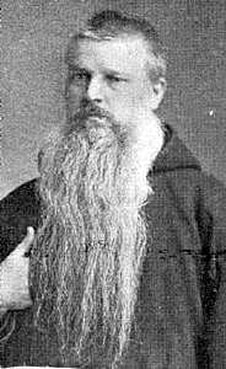 Fr. Lawrence Henn
Fr. Lawrence Henn
Fr. Lawrence Henn did not come as a stranger since he had been Pastor here from 1889 through 1891. While all the previous Capuchin Pastors had remained as pastor for no longer than a three year period, Fr. Lawrence succeeded himself twice. He is best remembered for his electrical installations, his painting of the buildings and his other manual work.
Shortly after his arrival, Fr. Lawrence began to plan for the 25th anniversary of the Capuchins being Pastors of St. Joe's. The anniversary celebration was held on April 20, 1902. In the afternoon, Bishop Messmer blessed the statue of St. Joseph as a pledge of the good will existing between the parishioners and the Capuchins. The statue was sculpted from Indiana limestone by the New York artist, Joseph Siebel. The cost was $524. That statue currently stands in front of our church.
In 1903, four new sanctuary windows were installed. As you can see today, the picture the Sorrowful Mother, St. Rose of Lima, and the famous Capuchin saints, Lawrence of Brindisi and Fidelis of Sigmaringen. Two of the windows were gifts to Fr. Lawrence on the occasion of his silver priestly jubilee. All four were imported from Munich and cost about $600.
During Fr. Lawrence's pastorate, the parish was slowly drifting from its German moorings. In the earlier days, all sermons were preached in German and all public prayers were recited in the same language. On Jan. 27, 1901, the first English sermon was preached at the 8:00 a.m. Mass. This was repeated on one Sunday each month for some time thereafter.
Even before this date, strenuous efforts had been made to preserve the use of the German language among the school children by compelling them to speak that langage during the recess periods on certain days of the week. It was a vain effort. On December 25, 1904, the first English sermon was preached at the 9:00 a.m. children's Mass, and this became the standard practice. The First World War dealt a death-blow to the use of German in the church. In the thirties, the use of the German language at public services was discontinued, and English became the language of this parish, which had origninally been entirely German.
The long pastorate of Fr. Lawrence came to an end in 1909. He left the parish with the universal good will of the parishioners. The spiritual advancement in the parish was quite marked.
Shortly after his arrival, Fr. Lawrence began to plan for the 25th anniversary of the Capuchins being Pastors of St. Joe's. The anniversary celebration was held on April 20, 1902. In the afternoon, Bishop Messmer blessed the statue of St. Joseph as a pledge of the good will existing between the parishioners and the Capuchins. The statue was sculpted from Indiana limestone by the New York artist, Joseph Siebel. The cost was $524. That statue currently stands in front of our church.
In 1903, four new sanctuary windows were installed. As you can see today, the picture the Sorrowful Mother, St. Rose of Lima, and the famous Capuchin saints, Lawrence of Brindisi and Fidelis of Sigmaringen. Two of the windows were gifts to Fr. Lawrence on the occasion of his silver priestly jubilee. All four were imported from Munich and cost about $600.
During Fr. Lawrence's pastorate, the parish was slowly drifting from its German moorings. In the earlier days, all sermons were preached in German and all public prayers were recited in the same language. On Jan. 27, 1901, the first English sermon was preached at the 8:00 a.m. Mass. This was repeated on one Sunday each month for some time thereafter.
Even before this date, strenuous efforts had been made to preserve the use of the German language among the school children by compelling them to speak that langage during the recess periods on certain days of the week. It was a vain effort. On December 25, 1904, the first English sermon was preached at the 9:00 a.m. children's Mass, and this became the standard practice. The First World War dealt a death-blow to the use of German in the church. In the thirties, the use of the German language at public services was discontinued, and English became the language of this parish, which had origninally been entirely German.
The long pastorate of Fr. Lawrence came to an end in 1909. He left the parish with the universal good will of the parishioners. The spiritual advancement in the parish was quite marked.
Past Pastor # 13 - Fr. Basil Gummerman (1909-1915)
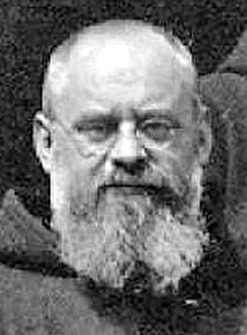 Fr. Basil Gummerman
Fr. Basil Gummerman
Fr. Basil Gummerman was born in Bavaria in 1876 and became our Pastor at the age of 33. One nagging problem that bothered him was the failure of the parish to strive to become debt-free. Often, the parish would take on a project with enthusiasm and begin to pay their obligations up to a certain amount, but then would halt their interest and let the debt linger. It was never a very large debt, in fact it had not yet gone much beyond $19,000, but neither had it ever gone below $8,000. Fr, Basil did not consider this condition necessary.
At the end of 1909, he announced to the people that the debt stood at $15,025. During the next year he stimulated interest in various activities to help raise funds. By the end of 1910, the debt was reduced to $10,000. The following year it was dropped to $6,000. At the end of 1914, Father Basil was happy to announce that the whole debt had been eliminated for the first time in the history of the parish. Up until 1923, debts had never again entered the financial books of the parish.
In the spring of 1910, much attention was given to discussing the obligations of the parish in the paving of Lawrence Street. The city completed the work in July and taxed the parish $1,808. As a result of this, access to the church and the school was much more convenient.
The year 1913 witnessed an improvement in the decoration of the church. Pictures of the stations were painted on the walls (our current stations are a remnant of these). To lighten up the church, new stained glass windows were installed (the ones we currently have). New electric fixtures were added which gave the whole church a tone of completeness.
On October 26, 1913, the parish commemorated the fortieth anniversary of the arrival of the School Sisters of Notre Dame. The sister were honored in the hall. As a gift, the parish provided them with new desks for their community room. The parishioners highly esteemed the teachers of their children.
In July, 1915, Fr. Basil came to the end of his second term in St. Joe's Parish. It was not to be the end of his administration in the parish; for he returned in 1921.
At the end of 1909, he announced to the people that the debt stood at $15,025. During the next year he stimulated interest in various activities to help raise funds. By the end of 1910, the debt was reduced to $10,000. The following year it was dropped to $6,000. At the end of 1914, Father Basil was happy to announce that the whole debt had been eliminated for the first time in the history of the parish. Up until 1923, debts had never again entered the financial books of the parish.
In the spring of 1910, much attention was given to discussing the obligations of the parish in the paving of Lawrence Street. The city completed the work in July and taxed the parish $1,808. As a result of this, access to the church and the school was much more convenient.
The year 1913 witnessed an improvement in the decoration of the church. Pictures of the stations were painted on the walls (our current stations are a remnant of these). To lighten up the church, new stained glass windows were installed (the ones we currently have). New electric fixtures were added which gave the whole church a tone of completeness.
On October 26, 1913, the parish commemorated the fortieth anniversary of the arrival of the School Sisters of Notre Dame. The sister were honored in the hall. As a gift, the parish provided them with new desks for their community room. The parishioners highly esteemed the teachers of their children.
In July, 1915, Fr. Basil came to the end of his second term in St. Joe's Parish. It was not to be the end of his administration in the parish; for he returned in 1921.
Past Pastor # 14 - Fr. Ludger Werth (1915-1921)
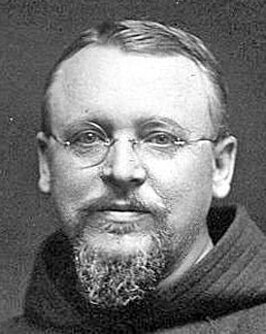 Fr. Ludger Werth
Fr. Ludger Werth
Fr. Ludger Werth was born in Germany, like all of the previous Capuchin pastors. Ludger was a man of indomitable energy and driving will power. Whatever he set his hand to, he did with sweeping vigor. Wherever he labored, he made hosts of friends.
Soon after his arrival, Fr. Ludger was plunged into enlarging the friary. Although a new friary had been built in 1890, it had become too small for the growing religious community. The cost of $11,440 was borne entirely by the friars with generous help of a kindly donor, a simple working woman, who insisted her name never be made known (Does anyone know who she is?)!
When the friary was just completed, an unexpected development regarding the hall was schemed by city hall. Since the new YMCA building had been erected at this time, its officials claimed tax exemption. City officials did not want to lose this source of revenue and announced that exemption could be claimed only on the grounds of educational purposes. So, they extended taxation to all church recreational centers. As a result, st. Joseph's hall was assessed a tax. Since such taxes imposed a heavy burden on the parish, an appeal was made to the state government. A decision was handed down in Madison stating the religious institutions must not be taxed.
During the summer of 1917 attention was again called to the cemetery when an appropriate stone arch was placed at its entrance. Although much attention was given to landscaping the grounds, little had been done for such monumental construction, save for the crucifix in the middle of the cemetery. Later much more was accomplished in this regard, so that St. Joseph’s Cemetery became one of the most beautiful cemeteries in the state!
Soon after his arrival, Fr. Ludger was plunged into enlarging the friary. Although a new friary had been built in 1890, it had become too small for the growing religious community. The cost of $11,440 was borne entirely by the friars with generous help of a kindly donor, a simple working woman, who insisted her name never be made known (Does anyone know who she is?)!
When the friary was just completed, an unexpected development regarding the hall was schemed by city hall. Since the new YMCA building had been erected at this time, its officials claimed tax exemption. City officials did not want to lose this source of revenue and announced that exemption could be claimed only on the grounds of educational purposes. So, they extended taxation to all church recreational centers. As a result, st. Joseph's hall was assessed a tax. Since such taxes imposed a heavy burden on the parish, an appeal was made to the state government. A decision was handed down in Madison stating the religious institutions must not be taxed.
During the summer of 1917 attention was again called to the cemetery when an appropriate stone arch was placed at its entrance. Although much attention was given to landscaping the grounds, little had been done for such monumental construction, save for the crucifix in the middle of the cemetery. Later much more was accomplished in this regard, so that St. Joseph’s Cemetery became one of the most beautiful cemeteries in the state!
Past Pastor # 15 - Fr. Josaphat Muesig (1918-1921)
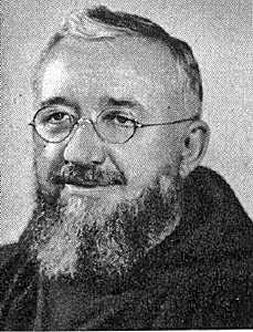 Fr. Josaphat Muesig
Fr. Josaphat Muesig
Fr. Josaphat Muegis was our first Capuchin pastor who was actually born in America. He was born in Milwaukee on January 7, 1887.
One of his first tasks was to work on repairs to the school. There had been many complaints about the inability to keep the school rooms warm. He had the windows caulked and provided with weather-stripping. Then the 650 children returned to their school in September, they found that the boys and girls were sent to separate rooms. For a few years, they had been put together in the same classrooms. Fr. Josaphat felt that separating the two sexes was in agreement with the wishes of the church.
The school year had just begun when an influenza epidemic broke out. School doors were closed throughout the city. The board of health even ordered churches to be closed for services. There seemed to be panic on all sides. Thankfully, in a short time, the flu epidemic was over.
There was joy in the country and at St. Joe's when on November 11, the signing of the armistice stopped the fighting of World War I. Celebrations were held as 203 young men and three Red Cross nurses of the parish returned home after serving their country.
And at the end of November, the parish was in a happy mood on the celebration of the parish's golden anniversary. A three day celebration was held with dignitaries from the diocese in attendance. We still have eight onyx and gold candlesticks that were purchased to commemorate our 50 years.
From September 15 through November 1, 1919, regular church services were conducted in the hall because a new floor was installed in the church. Terrazzo was put upon a four inch foundation of cement throughout the body of the church, except for the aisles where tiles were laid (this is the floor we have today).
At this same time, a drive was carried on to provide funds for building a new St. Elizabeth Hospital. The aim was to raise $85,000. Fr. Josaphat pledged $40,000 as the target of St. Joseph's Parish. Parishioners enthusiastically met that goal. Even though the hospital was not a parish institution, the parishioners understood the necessity of this new building program and were willing to lend the aid to help the Franciscan Sisters to secure a modern hospital facility for Appleton.
One of his first tasks was to work on repairs to the school. There had been many complaints about the inability to keep the school rooms warm. He had the windows caulked and provided with weather-stripping. Then the 650 children returned to their school in September, they found that the boys and girls were sent to separate rooms. For a few years, they had been put together in the same classrooms. Fr. Josaphat felt that separating the two sexes was in agreement with the wishes of the church.
The school year had just begun when an influenza epidemic broke out. School doors were closed throughout the city. The board of health even ordered churches to be closed for services. There seemed to be panic on all sides. Thankfully, in a short time, the flu epidemic was over.
There was joy in the country and at St. Joe's when on November 11, the signing of the armistice stopped the fighting of World War I. Celebrations were held as 203 young men and three Red Cross nurses of the parish returned home after serving their country.
And at the end of November, the parish was in a happy mood on the celebration of the parish's golden anniversary. A three day celebration was held with dignitaries from the diocese in attendance. We still have eight onyx and gold candlesticks that were purchased to commemorate our 50 years.
From September 15 through November 1, 1919, regular church services were conducted in the hall because a new floor was installed in the church. Terrazzo was put upon a four inch foundation of cement throughout the body of the church, except for the aisles where tiles were laid (this is the floor we have today).
At this same time, a drive was carried on to provide funds for building a new St. Elizabeth Hospital. The aim was to raise $85,000. Fr. Josaphat pledged $40,000 as the target of St. Joseph's Parish. Parishioners enthusiastically met that goal. Even though the hospital was not a parish institution, the parishioners understood the necessity of this new building program and were willing to lend the aid to help the Franciscan Sisters to secure a modern hospital facility for Appleton.
Past Pastor # 16 - Fr. Basil Gummerman (1921-1924)
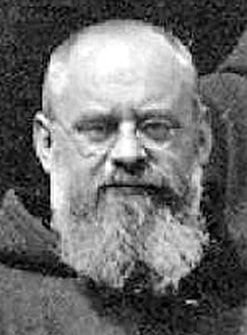 Fr. Basil Gummerman
Fr. Basil Gummerman
Fr Basil Gummerman is no stranger to St Joe’s. He had been Pastor here from 1909-1915 and now returned for another three years.
Fr Basil was more convinced than ever that better living quarters should be provided for the sisters. He found 720 children in the school. Altho‘ both school buildings were fully occupied by the pupils and part of the hall was used for school purposes, sufficient space could not be found for this great number that was constantly increasing. Such cramped conditions were evident even more in the living quarters of the sisters.
Building a new convent had been in the minds of the parishioners for some time, but no one seemed to have enough courage to undertake the project. Building costs had risen considerably and new property would have to be acquired. Yet, the parish was free of debt and the parishioners had shown their ability to undertake a major project without too much difficulty.
Therefore Fr Basil, with the approval of the parishioners, took the first steps in the matter as early as Jan 30, 1922 by purchasing the Hopfensberger property on High street. A building permit was issued Dec 31, 1923 for a brick and tile structure 85 x 50, thirty feet in
height. Estimated cost $58,000. Unfortunate circumstances prevented the convent from facing the street, so that it had to be hidden behind the second school. The general contract was given to the Hoffman Construction Co.
Since Fr Basil had previously collected funds for the project, the burden on the parish was not too heavy. In fact, it was paid within two years after the completion of the building. Fr Basil was able to see the beginnings of the convent construction, but was given another assignment by his Capuchin superiors in July, 1924.
Fr Basil was more convinced than ever that better living quarters should be provided for the sisters. He found 720 children in the school. Altho‘ both school buildings were fully occupied by the pupils and part of the hall was used for school purposes, sufficient space could not be found for this great number that was constantly increasing. Such cramped conditions were evident even more in the living quarters of the sisters.
Building a new convent had been in the minds of the parishioners for some time, but no one seemed to have enough courage to undertake the project. Building costs had risen considerably and new property would have to be acquired. Yet, the parish was free of debt and the parishioners had shown their ability to undertake a major project without too much difficulty.
Therefore Fr Basil, with the approval of the parishioners, took the first steps in the matter as early as Jan 30, 1922 by purchasing the Hopfensberger property on High street. A building permit was issued Dec 31, 1923 for a brick and tile structure 85 x 50, thirty feet in
height. Estimated cost $58,000. Unfortunate circumstances prevented the convent from facing the street, so that it had to be hidden behind the second school. The general contract was given to the Hoffman Construction Co.
Since Fr Basil had previously collected funds for the project, the burden on the parish was not too heavy. In fact, it was paid within two years after the completion of the building. Fr Basil was able to see the beginnings of the convent construction, but was given another assignment by his Capuchin superiors in July, 1924.
Past Pastor # 17 - Fr. Pacificus Raith (1924-1930)
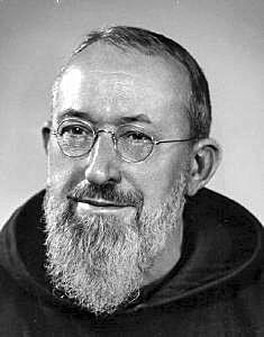 Fr. Pacificus Raith
Fr. Pacificus Raith
Fr. Pacificus Raith was born in Bavaria in 1874. He was assigned as Pastor at the age of 50 and served two terms here. Both of these terms were periods of apprehension, since he was aware of plans to for a new parish (St. Therese). He knew there would be repercussions as a result. (Remember.. back in 1898, Sacred Heart parish was formed out of St. Joseph and St. Mary parishioners.) When it finally came about in 1927, during his second term, he did all in his power to help the new parish become successful. But the cloud seemed to hover over all major discussions during the previous years.
Despite the apprehension he felt regarding the formation of a new parish, Fr. Pacificus embarked upon another effort in the autumn of 1925. He opened ninth grade in the school with the promise that the children who enrolled could remain for a full high school course. Thirty boys and thirty girls entered that first ninth grade. However, the hope for a high school was dampened when the state building inspector kept insisting the school building was too crowded and demanded more and more safety repairs. The only way to continue the high school was to build another building. That issue, along with the impending forming of a new parish which would take away parishioners and school children, caused the high school project to be dropped. Appleton was still without a Catholic high school.
Another issue was the old church organ. It had gone through many repairs and finally on April 17, 1929, it was decided that a new pipe organ should be installed. Schaefer Co. of Slinger who had built the old organ built a new one. This organ has 2,073 pipes and is a three-manual instrument. The total cost was $12,000 (this is the organ that we now can see in the choir loft. However, the original console has been replaced by the the new console on the church floor).
Complaints were also heard about the poor acoustics in the church. To remedy this condition, a public address system was installed in 1929. It was not perfect, but at least some improvement was noted.
On January 6, 1929, Fr. Pacificus published the first parish bulletin. It usually contained four sides of reading material. Parishioners could now leisurely read the important parish announcements of the week, including the holy Mass intentions and also digest some articles on religious topics in the quiet of their homes
An important decision of Bishop Rhode was read from all the Catholic pulpits of the city on July 11, 1926. It announced the establishment of a new parish to be dedicated to St. Therese, the Little Flower. The whole district north of Wisconsin Ave. and south of Atlantic Street, running east from Richmond Street was thus severed from St. Joseph and St. Mary Parishes. St. Joe's was taxed $30,000 to provide a working fund for the new parish.
In order to raise the tax of $30,000, Fr. Pacificus introduced the envelope system of contributions. It brought gratifying results.
St. Joe's history proudly acknowledges that two parishes (Sacred Heart and St. Therese) came to existence from its own members. Financial sacrifices were made to help them get started.
Despite the apprehension he felt regarding the formation of a new parish, Fr. Pacificus embarked upon another effort in the autumn of 1925. He opened ninth grade in the school with the promise that the children who enrolled could remain for a full high school course. Thirty boys and thirty girls entered that first ninth grade. However, the hope for a high school was dampened when the state building inspector kept insisting the school building was too crowded and demanded more and more safety repairs. The only way to continue the high school was to build another building. That issue, along with the impending forming of a new parish which would take away parishioners and school children, caused the high school project to be dropped. Appleton was still without a Catholic high school.
Another issue was the old church organ. It had gone through many repairs and finally on April 17, 1929, it was decided that a new pipe organ should be installed. Schaefer Co. of Slinger who had built the old organ built a new one. This organ has 2,073 pipes and is a three-manual instrument. The total cost was $12,000 (this is the organ that we now can see in the choir loft. However, the original console has been replaced by the the new console on the church floor).
Complaints were also heard about the poor acoustics in the church. To remedy this condition, a public address system was installed in 1929. It was not perfect, but at least some improvement was noted.
On January 6, 1929, Fr. Pacificus published the first parish bulletin. It usually contained four sides of reading material. Parishioners could now leisurely read the important parish announcements of the week, including the holy Mass intentions and also digest some articles on religious topics in the quiet of their homes
An important decision of Bishop Rhode was read from all the Catholic pulpits of the city on July 11, 1926. It announced the establishment of a new parish to be dedicated to St. Therese, the Little Flower. The whole district north of Wisconsin Ave. and south of Atlantic Street, running east from Richmond Street was thus severed from St. Joseph and St. Mary Parishes. St. Joe's was taxed $30,000 to provide a working fund for the new parish.
In order to raise the tax of $30,000, Fr. Pacificus introduced the envelope system of contributions. It brought gratifying results.
St. Joe's history proudly acknowledges that two parishes (Sacred Heart and St. Therese) came to existence from its own members. Financial sacrifices were made to help them get started.
Past Pastor # 18 - Fr. Crescentian Voelpel (1930 - 1933)
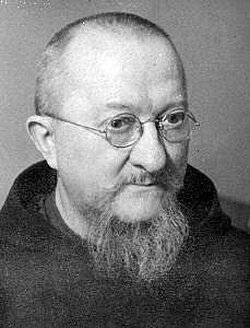 Fr. Crescentian Voelpel
Fr. Crescentian Voelpel
Fr. Crescential Voelpel was the second Pastor of St. Joe's born in America. His life began in New York City in 1875. At the age of 55, he became our 18th Pastor.
If he had a nickname, it could have been Fr. Crescentian, "The Painter". He was often seen in overalls with a paint brush in his hands. During his three years as Pastor, he had most of the woodwork refinished through painting and varnishing.
In the summer of 1932, attention was given to the ventilation of the church and hall, which had been the cause of many complaints. A ventilating system was installed for the church and the hall. It seemed that many positive comments followed.
Much work was also done on the cemetery during these three years. A new imported crucifixion group was dedicated. It forms the principal monumental attraction of the cemetery as it stands in the middle of the cemetery to this very day.
One of the main interests of Fr. Crescentian was the promotion of a Catholic high school education, After the debacle of a Catholic high school in the parish, he was determined to have such an education for as many young people as possible. He made arrangements with St. Mary's High School in Menasha. To help persuade the parents of ninth grade graduates to send their children to that school, he offered to pay part of their tuition and to make arrangements for their transportation. He was disappointed when only seven girls and one boy responded to his invitation in 1930. The next year, the number was advanced to twenty-three. In 1932, forty pupils were registered at St. Mary's. The continual prodding of the pastor had the effect of producing some added interest for the plan of a central Catholic high school in Appleton. At a meeting of the Appleton pastors in October, 1931, the matter was thoroughly discussed. However, when the bishop stated that no diocesan funds were available for such a project, the enthusiasm was diminished. It was felt at that time the parishes of St. Mary and St. Joseph would have to bear practically all of the costs. This was not considered equitable and the matter was dropped.
When Fr. Crescentian left as pastor in 1933, he had served the parish well through the constant care he gave to the parish buildings and having stressed the importance of a Catholic high school.
If he had a nickname, it could have been Fr. Crescentian, "The Painter". He was often seen in overalls with a paint brush in his hands. During his three years as Pastor, he had most of the woodwork refinished through painting and varnishing.
In the summer of 1932, attention was given to the ventilation of the church and hall, which had been the cause of many complaints. A ventilating system was installed for the church and the hall. It seemed that many positive comments followed.
Much work was also done on the cemetery during these three years. A new imported crucifixion group was dedicated. It forms the principal monumental attraction of the cemetery as it stands in the middle of the cemetery to this very day.
One of the main interests of Fr. Crescentian was the promotion of a Catholic high school education, After the debacle of a Catholic high school in the parish, he was determined to have such an education for as many young people as possible. He made arrangements with St. Mary's High School in Menasha. To help persuade the parents of ninth grade graduates to send their children to that school, he offered to pay part of their tuition and to make arrangements for their transportation. He was disappointed when only seven girls and one boy responded to his invitation in 1930. The next year, the number was advanced to twenty-three. In 1932, forty pupils were registered at St. Mary's. The continual prodding of the pastor had the effect of producing some added interest for the plan of a central Catholic high school in Appleton. At a meeting of the Appleton pastors in October, 1931, the matter was thoroughly discussed. However, when the bishop stated that no diocesan funds were available for such a project, the enthusiasm was diminished. It was felt at that time the parishes of St. Mary and St. Joseph would have to bear practically all of the costs. This was not considered equitable and the matter was dropped.
When Fr. Crescentian left as pastor in 1933, he had served the parish well through the constant care he gave to the parish buildings and having stressed the importance of a Catholic high school.
Past Pastor # 19 - Fr. Gaudentius Rossman (1933-1936)
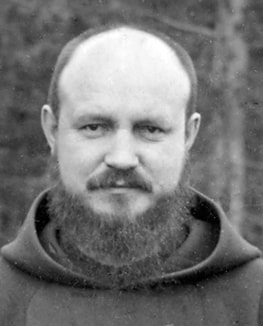 Fr. Gaudentius Rossman
Fr. Gaudentius Rossman
Fr. Gaudentius Rossmann was born in 1883 in Bavaria, Germany. At the age of fifty, he was assigned to our parish as Pastor #19.
He emphasized the importance of the annual visitation of the parish combined with census taking. The Capuchins assigned to St. Joe's all participated in visiting not only the actual members of the parish but also those who had stopped practicing their religion. Thus, they brought back many to the faith and had many additional children registered in the parochial school. Its attendance rose from 705 at his arrival to 777 in the last year of his pastorate.
In 1935, city officials proposed to build an open swimming pool in Jones Park, just below the convent of the Sisters. It would have been most annoying to the good Sisters. The matter was carefully discussed and finally the Holy Name Society put in a firm protest. Although the measure was passed in the city council, it was never put into operation.
Although proper decorum is always observed in the church, the younger members of the parish found its observance almost impossible one August evening in 1935 when the stations were being prayed. At that time, the first truck pulled up to the church with its usual clamor and the firemen hurried up the stairs of the tower. A fire had been reported in the steeple. When they got to the top, ready to extinguish the flames, they found a swarm of bees which appeared like wisps of smoke from the street. This is a reminder of the stories told about the early days, when one of the Capuchin Brothers observed a huge fire on the horizon some distance from the outskirts of the town. He rang the bell to sound the alarm. Conscious of their duty, the firemen hurried in the direction of the reported fire with all their equipment.. towards the rising full moon.
Fr. Gaudentius had started his term of office in the full spirit of vigilant care for his parishioners. Within a short period, however, he became less capable of performing the strenuous parochial duties and had to rely more and more upon the help of his capable assistants. A malignant disease was creeping up on him, slowly weakening his physical powers. During the summer of 1935, he was compelled to undergo a protracted rest cure at a sanatorium. Many prayers were sent up to heaven for his recovery, particularly by the school children and the men of the Holy Name Society. He returned after several months, but his strength had been sapped to such an extent that he was able to act only in advisory capacity. There could be no thought of his re-appointment as Pastor in 1936 and he was transferred to the friary in Detroit.
He emphasized the importance of the annual visitation of the parish combined with census taking. The Capuchins assigned to St. Joe's all participated in visiting not only the actual members of the parish but also those who had stopped practicing their religion. Thus, they brought back many to the faith and had many additional children registered in the parochial school. Its attendance rose from 705 at his arrival to 777 in the last year of his pastorate.
In 1935, city officials proposed to build an open swimming pool in Jones Park, just below the convent of the Sisters. It would have been most annoying to the good Sisters. The matter was carefully discussed and finally the Holy Name Society put in a firm protest. Although the measure was passed in the city council, it was never put into operation.
Although proper decorum is always observed in the church, the younger members of the parish found its observance almost impossible one August evening in 1935 when the stations were being prayed. At that time, the first truck pulled up to the church with its usual clamor and the firemen hurried up the stairs of the tower. A fire had been reported in the steeple. When they got to the top, ready to extinguish the flames, they found a swarm of bees which appeared like wisps of smoke from the street. This is a reminder of the stories told about the early days, when one of the Capuchin Brothers observed a huge fire on the horizon some distance from the outskirts of the town. He rang the bell to sound the alarm. Conscious of their duty, the firemen hurried in the direction of the reported fire with all their equipment.. towards the rising full moon.
Fr. Gaudentius had started his term of office in the full spirit of vigilant care for his parishioners. Within a short period, however, he became less capable of performing the strenuous parochial duties and had to rely more and more upon the help of his capable assistants. A malignant disease was creeping up on him, slowly weakening his physical powers. During the summer of 1935, he was compelled to undergo a protracted rest cure at a sanatorium. Many prayers were sent up to heaven for his recovery, particularly by the school children and the men of the Holy Name Society. He returned after several months, but his strength had been sapped to such an extent that he was able to act only in advisory capacity. There could be no thought of his re-appointment as Pastor in 1936 and he was transferred to the friary in Detroit.
Past Pastor # 20 - Fr. Cyprian Abler (1936-1945)
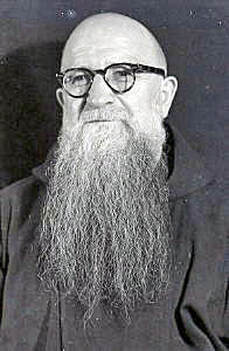 Fr. Cyprian Abler
Fr. Cyprian Abler
Fr. Cyprian Abler was born in a log cabin between St. Joe and Marytown, WI in 1885. From those humble beginnings, he would go on to become one of the best known Capuchins of the Province.
Fr. Cyprian's first thought as Pastor was to make the church beautiful and attractive for divine service. Before doing any work on the inside of the church, a new roof was needed. Asbestos shingles were therefore laid in 1936. At the same time, a new vestibule was planned to extend along the whole front of the church. The cement steps had been a great improvement in their time but they proved hazardous in icy weather and a source of annoyance when it snowed. The new vestibule was extended down the sidewalk, putting all the stairs under cover. A new lighting system and new electric fixtures were installed throughout the church to provide better lighting for the people in the pews. To regulate the temperature, the church was insulated in 1941. Later, all the buildings received the same treatment. In the summer of 1941, the kneelers of the church were made more comfortable with air-foam pads, thus removing the excuse for not kneeling during divine services. At the same time, another public address system was installed in the church.
In the month of January, 1943, the Dohr hotel, located on Walnut St. just west of the church, was bought for $14,000. The hotel would be utilized as an annex to St. Joseph's School for the religious instruction of the children attending public schools.
The removal of snow from the extensive sidewalk space of the church property was made easier by the acquisition of a small tractor plow. The friars were presented with an automobile to help them get around to visit the parishioners. Prior to this time, the friars were dependent upon the good will of parishioners for their transportation.
Fr. Cyprian also realized his responsibility for the spiritual welfare not only of his own parishioners, but also of others within the boundaries of the parish. In order to assist those who knew little or nothing about the faith, he had lectures for non-Catholics introduced. His lectures were so successful that he was frequently called upon to address non-Catholic bodies. In order to reach a wider audience, he inaugurated a series of lectures at Pierce Park with the support of the local Knights of Columbus. As a preacher, his directness, sincerity, relevance and powerful voice left an impression.
The specter of seeing the parish divided once more confronted Fr. Cyprian and the parishioners. The thought of this new separation acted as a pall on many activities because it was expected to cut more deeply into the body of the old parishes. Fr. Cyprian approached Bishop Rhode in 1940 about the advisability of erecting a new parish school for St. Joe's. He was told that the founding of a new parish was beyond doubt and that a new school building might then be no longer necessary.
Fr. Cyprian's first thought as Pastor was to make the church beautiful and attractive for divine service. Before doing any work on the inside of the church, a new roof was needed. Asbestos shingles were therefore laid in 1936. At the same time, a new vestibule was planned to extend along the whole front of the church. The cement steps had been a great improvement in their time but they proved hazardous in icy weather and a source of annoyance when it snowed. The new vestibule was extended down the sidewalk, putting all the stairs under cover. A new lighting system and new electric fixtures were installed throughout the church to provide better lighting for the people in the pews. To regulate the temperature, the church was insulated in 1941. Later, all the buildings received the same treatment. In the summer of 1941, the kneelers of the church were made more comfortable with air-foam pads, thus removing the excuse for not kneeling during divine services. At the same time, another public address system was installed in the church.
In the month of January, 1943, the Dohr hotel, located on Walnut St. just west of the church, was bought for $14,000. The hotel would be utilized as an annex to St. Joseph's School for the religious instruction of the children attending public schools.
The removal of snow from the extensive sidewalk space of the church property was made easier by the acquisition of a small tractor plow. The friars were presented with an automobile to help them get around to visit the parishioners. Prior to this time, the friars were dependent upon the good will of parishioners for their transportation.
Fr. Cyprian also realized his responsibility for the spiritual welfare not only of his own parishioners, but also of others within the boundaries of the parish. In order to assist those who knew little or nothing about the faith, he had lectures for non-Catholics introduced. His lectures were so successful that he was frequently called upon to address non-Catholic bodies. In order to reach a wider audience, he inaugurated a series of lectures at Pierce Park with the support of the local Knights of Columbus. As a preacher, his directness, sincerity, relevance and powerful voice left an impression.
The specter of seeing the parish divided once more confronted Fr. Cyprian and the parishioners. The thought of this new separation acted as a pall on many activities because it was expected to cut more deeply into the body of the old parishes. Fr. Cyprian approached Bishop Rhode in 1940 about the advisability of erecting a new parish school for St. Joe's. He was told that the founding of a new parish was beyond doubt and that a new school building might then be no longer necessary.
Past Pastor # 21 - Fr. Alphonse Heckler (1945-1952)
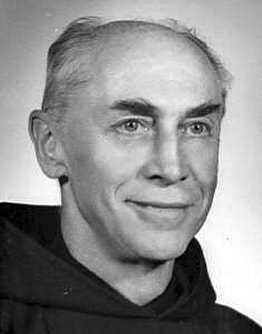 Fr. Alphonse Heckler
Fr. Alphonse Heckler
Fr. Alphonse Heckler was born in Milwaukee in 1902. At the age of 43, he became Pastor of St. Joseph Parish. According to the pictures of all our Pastors, he was the first one who did not possess one of those impressive beards!
Fr. Alphonse was very talented and served in a number of capacities in the Capuchin Province. He was a teacher, pastor, preacher and spiritual assistant to the Secular Franciscans. He had a very practical bent. He always had to be doing something and gave himself entirely over to the task at hand. He was especially proud of having built the grade school here at St. Joe's. This certainly was his greatest accomplishment and we can devote ourselves to all that it represents.
From its very beginning, St. Joseph Parish provided Catholic education for its children. At first, there was only one classroom; soon a second was opened in an old dilapidated building overhanging the ravine. By 1877, additional space was provided in the old tower behind the rectory and a year later, two more rooms on College Ave accommodated the rapidly increasing number of school children.
A permanent school was finally erected in 1880, containing eight classrooms. This building was so well constructed that it was used until early 1950. With the growing number of students, it became evident in 1906 that additional space was needed, and the following year, a school of six rooms was erected on the south side of Lawrence St.
In the middle thirties when the "old" school had reached the half century mark, the need of more adequate facilities for our children was evident. Although efforts were made to prepare plans, the depression and subsequent World War II delayed the realization of this project. Then came the year 1947 with its tremendous increase in the birthrate. In that year, one fourth of all children born in the City of Appleton were baptized in St. Joseph Church. It was now critical to increase our school capacity as soon as possible.
The only available area on parish grounds was on the south side of Lawrence St. which was then occupied by the parish hall, a six room school building and the janitor's house. With outstanding generosity and determination, a new school and gymnasium were built and dedicated on August 31, 1952.
The school had the shape of a capital "F". The vertical bar contained 18 classrooms on two levels above the ground. The upper cross bar of the "F" represented the gym and the short center bar contained the main entrance to the school. A large, modern cafeteria sat below the gym. The boys' and girls' shower and locker rooms were on either side of the kitchen.
The dedication booklet had a closing paragraph from Fr. Alphonse: "May God continue to bless this parish and may your cooperation for the welfare of our children bring you the happiness your sacrifices so richly deserve."
One other item of interest during this time period is noted in a bulletin for Oct. 10, 1948. Weekday Masses were at 6:00, 6:30, 7:15 and 8:00 a.m. Sunday Masses were at 5:30, 6:45, 8:00, 9:15, 10:30 (High Mass) and 12:00 noon. (Obviously, there was more than one Capuchin priest assigned to St. Joe's at that time).
Fr. Alphonse was very talented and served in a number of capacities in the Capuchin Province. He was a teacher, pastor, preacher and spiritual assistant to the Secular Franciscans. He had a very practical bent. He always had to be doing something and gave himself entirely over to the task at hand. He was especially proud of having built the grade school here at St. Joe's. This certainly was his greatest accomplishment and we can devote ourselves to all that it represents.
From its very beginning, St. Joseph Parish provided Catholic education for its children. At first, there was only one classroom; soon a second was opened in an old dilapidated building overhanging the ravine. By 1877, additional space was provided in the old tower behind the rectory and a year later, two more rooms on College Ave accommodated the rapidly increasing number of school children.
A permanent school was finally erected in 1880, containing eight classrooms. This building was so well constructed that it was used until early 1950. With the growing number of students, it became evident in 1906 that additional space was needed, and the following year, a school of six rooms was erected on the south side of Lawrence St.
In the middle thirties when the "old" school had reached the half century mark, the need of more adequate facilities for our children was evident. Although efforts were made to prepare plans, the depression and subsequent World War II delayed the realization of this project. Then came the year 1947 with its tremendous increase in the birthrate. In that year, one fourth of all children born in the City of Appleton were baptized in St. Joseph Church. It was now critical to increase our school capacity as soon as possible.
The only available area on parish grounds was on the south side of Lawrence St. which was then occupied by the parish hall, a six room school building and the janitor's house. With outstanding generosity and determination, a new school and gymnasium were built and dedicated on August 31, 1952.
The school had the shape of a capital "F". The vertical bar contained 18 classrooms on two levels above the ground. The upper cross bar of the "F" represented the gym and the short center bar contained the main entrance to the school. A large, modern cafeteria sat below the gym. The boys' and girls' shower and locker rooms were on either side of the kitchen.
The dedication booklet had a closing paragraph from Fr. Alphonse: "May God continue to bless this parish and may your cooperation for the welfare of our children bring you the happiness your sacrifices so richly deserve."
One other item of interest during this time period is noted in a bulletin for Oct. 10, 1948. Weekday Masses were at 6:00, 6:30, 7:15 and 8:00 a.m. Sunday Masses were at 5:30, 6:45, 8:00, 9:15, 10:30 (High Mass) and 12:00 noon. (Obviously, there was more than one Capuchin priest assigned to St. Joe's at that time).
Past Pastor # 22 - Fr. Peter Hesse (1952-1955)
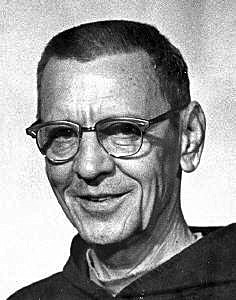 Fr. Peter Hesse
Fr. Peter Hesse
Fr. Peter Hesse was born in Wisconsin Rapids in 1918. Becoming our Pastor at the age of 34 made him one of the youngest pastors we ever had. In the three years that he was here, he put the finishing touches on our new grade school.
Fr. Peter had been a teacher at Mt. Calvary and truthfully, teaching was his first love. He had little interest in parish work, but he fulfilled his obligations nonetheless. After three years, he was given an appointment at Marathon, back to his first love, teaching.
Fr. Peter had been a teacher at Mt. Calvary and truthfully, teaching was his first love. He had little interest in parish work, but he fulfilled his obligations nonetheless. After three years, he was given an appointment at Marathon, back to his first love, teaching.
Past Pastor # 23 - Fr. Kenneth Barnes (1955-1961)
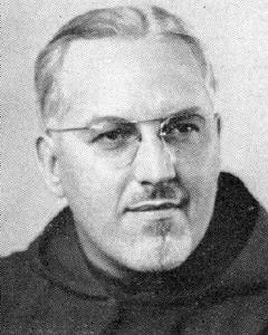 Fr. Kenneth Barnes
Fr. Kenneth Barnes
Fr. Kenneth Barnes was born in Fond du Lac on November 11, 1911. At the age of 44, he came to St. Joe's as our 23rd Pastor. He was our sixth American-born Pastor. As Pastor, Fr. Kenneth made some controversial decisions. He changed the interior appearance of the church dramatically (at least some parishioners thought so). All the statues and the ornate tops of the altars were removed. The explanation or excuse given was that they were deteriorating. There is no question that this drew the consternation of many parishioners. Fr. Kenneth also purchased the sanctuary organ. Many were against his innovations but went along with them.
Fr. Kenneth was a person who looked like his smile was painted on him.. it just never went away. He cut an impressive image of a Capuchin with his snow white hair and immaculate appearance. He was scrupulously neat. Never would you find his desk littered with papers. After completing whatever he had been doing at his desk, everything was put back into place. Everything had its place you can be sure.
In our parish baptismal books, there are recorded 190 baptisms that Fr. Kenneth performed during his six years at St. Joe's. In those days, most of the baptisms were performed by the assistant Pastors. If Fr. Kenneth performed 190 baptisms, then more than 1000 were offered by the Assistants. There were a lot of Assistants assigned here during Fr. Kenneth's time: Fr. Ulric Buening, Fr. Austin Schlaefer, Fr. Edmund Kraemer, Fr. Ward Schnur, Fr. Bertin Samsa, Fr. Foster Bonneprise, Fr. Lyle Peyovich, Fr. Joseph Smetana, and Fr. George Henseler (who would become Pastor #25 in three years).
Fr. Kenneth was a person who looked like his smile was painted on him.. it just never went away. He cut an impressive image of a Capuchin with his snow white hair and immaculate appearance. He was scrupulously neat. Never would you find his desk littered with papers. After completing whatever he had been doing at his desk, everything was put back into place. Everything had its place you can be sure.
In our parish baptismal books, there are recorded 190 baptisms that Fr. Kenneth performed during his six years at St. Joe's. In those days, most of the baptisms were performed by the assistant Pastors. If Fr. Kenneth performed 190 baptisms, then more than 1000 were offered by the Assistants. There were a lot of Assistants assigned here during Fr. Kenneth's time: Fr. Ulric Buening, Fr. Austin Schlaefer, Fr. Edmund Kraemer, Fr. Ward Schnur, Fr. Bertin Samsa, Fr. Foster Bonneprise, Fr. Lyle Peyovich, Fr. Joseph Smetana, and Fr. George Henseler (who would become Pastor #25 in three years).
Past Pastor # 24 - Fr. Nathaniel Sonntag (1961-1964)
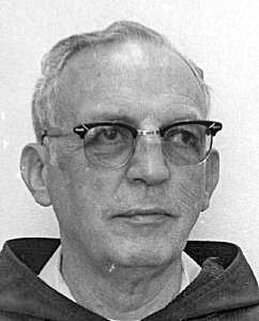 Fr. Nathaniel Sonntag
Fr. Nathaniel Sonntag
Fr. Nathaniel Sonntag was born in Sheboygan, Wisconsin on December 9, 1915. Fr. Nathaniel was Pastor during some of our great national events: Martin Luther King, Jr's march on Washington, President Kennedy was assassinated, and the Beatles appeared on the Ed Sullivan show. For sure the events at St. Joe's were not as significant, but the parish continued to meet it's responsibilities thanks to Fr. Nathaniel's conscientiousness.
He was very methodical and systematized all his duties which was a big help in getting things done. Besides his many duties as Pastor, he was the spiritual director of the Third Order which he took very seriously. After leaving St. Joe's, Fr. Nathaniel spent over ten years in Provincial administration. From there, he volunteered for the foreign missions where he served in Nicaragua for 21 years.
He was very methodical and systematized all his duties which was a big help in getting things done. Besides his many duties as Pastor, he was the spiritual director of the Third Order which he took very seriously. After leaving St. Joe's, Fr. Nathaniel spent over ten years in Provincial administration. From there, he volunteered for the foreign missions where he served in Nicaragua for 21 years.
Past Pastor # 25 - Fr. George Henseler (1964-1969)
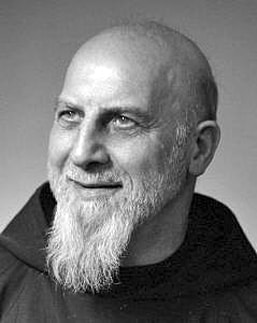 Fr. George Henseler
Fr. George Henseler
Fr. George Henseler was born in Marshfield, Wisconsin on July 26, 1905. He followed Fr. Nathaniel as our 25th Pastor and made an indelible imprint on St. Joe's Parish just as Fr. Cyrian did. Back in 1964, our first Mass on Sunday morning was at 5:30 a.m. If we had a snow storm the night before, you could be sure Fr. George was out there helping the janitors with the snow removal. He loved to operate the old snow blower.
His trademark was his pipe. The only time he set it aside was at the altar or in the confessional. Next to his pipe, he loved birds. He was an avid bird watcher. His relaxation was studying birds and he could be found in nearby fields catching and banding new varieties.
During his years at St. Joe's, Fr. George introduced tithing tot he parish. It wasn't received with great enthusiasm by the parishioners, but there were some who responded.
Another of his ambitions was Catholic education or all our youth. He introduced the system whereby any student would have a chance to attend Catholic school... the parish picking up the cost. This would have been successful if a complete program of tithing would have been adopted. However, despite his pleading, because he felt so deeply it was the right thing to do, the program ran the parish into a large debt. This certainly intensified his own personal anguish.
Fr. George was just an ordinary man. He was a listener, but sometimes so quiet that you wondered whether he heard you. Children flocked to him. They told stories to him. He would smoke his pipe and listen to them.
His sudden death in June, 1969, came as a shock to everyone. He was attending a Capuchin Chapter meeting at Monte Alverno Retreat House when death approached him suddenly and took him quickly and silently. He was buried from St. Joseph Church.
The following was one of the tributes shared at his funeral: "The 'real monk', Fr. George, is now preparing to celebrate his resurrection. His sole possessions remain behind: A Capuchin habit, his rosary, his sandals, his keys to the school, and his wallet.. empty."
His trademark was his pipe. The only time he set it aside was at the altar or in the confessional. Next to his pipe, he loved birds. He was an avid bird watcher. His relaxation was studying birds and he could be found in nearby fields catching and banding new varieties.
During his years at St. Joe's, Fr. George introduced tithing tot he parish. It wasn't received with great enthusiasm by the parishioners, but there were some who responded.
Another of his ambitions was Catholic education or all our youth. He introduced the system whereby any student would have a chance to attend Catholic school... the parish picking up the cost. This would have been successful if a complete program of tithing would have been adopted. However, despite his pleading, because he felt so deeply it was the right thing to do, the program ran the parish into a large debt. This certainly intensified his own personal anguish.
Fr. George was just an ordinary man. He was a listener, but sometimes so quiet that you wondered whether he heard you. Children flocked to him. They told stories to him. He would smoke his pipe and listen to them.
His sudden death in June, 1969, came as a shock to everyone. He was attending a Capuchin Chapter meeting at Monte Alverno Retreat House when death approached him suddenly and took him quickly and silently. He was buried from St. Joseph Church.
The following was one of the tributes shared at his funeral: "The 'real monk', Fr. George, is now preparing to celebrate his resurrection. His sole possessions remain behind: A Capuchin habit, his rosary, his sandals, his keys to the school, and his wallet.. empty."
Past Pastor # 26 - Fr. Simeon Keogh (1969-1970)
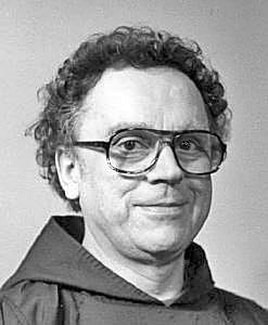 Fr. Simeon Keogh
Fr. Simeon Keogh
Fr. Simeon Keogh was born in Toledo, Ohio on October 7, 1921. With Fr. George's sudden death, Fr. Simeon was asked to become our 26th Pastor for a year. Unlike the previous 25 German Pastors, he possessed the refreshing flair of an Irishman! He embodied a new style of leadership which reflected the influences of Vatican II. His greatest gift and legacy was his more casual, brotherly leadership style. He ushered in a new era and helped break down the traditional customs, roles and distinctions between clerics and lay brothers. Fr. Simeon brought joy to the community and animated others. He never shied away from things he enjoyed: dressing as a clown, rug hooking and baking.
As lovable as he was, Fr. Simeon enacted the changes dictated by the Vatican Council. It was not easy for parishioners to accept some of the changes, but he moved forward just the same. He turned the altar to face the people. Most of the marble communion rail was eliminated, although mini-rails were kept for quite a while. He arranged the officiating chairs to face the people. Also, the tabernacle was moved from the high altar after a lengthy discussion.
Abandoning Latin with the vernacular really woke some people up. Hootenanny Masses were a bit scandalous for some but exciting for others. It was a time of great upheaval in the church. Was there a better man to deal with all that than our beloved Fr. Simeon Keogh?
As lovable as he was, Fr. Simeon enacted the changes dictated by the Vatican Council. It was not easy for parishioners to accept some of the changes, but he moved forward just the same. He turned the altar to face the people. Most of the marble communion rail was eliminated, although mini-rails were kept for quite a while. He arranged the officiating chairs to face the people. Also, the tabernacle was moved from the high altar after a lengthy discussion.
Abandoning Latin with the vernacular really woke some people up. Hootenanny Masses were a bit scandalous for some but exciting for others. It was a time of great upheaval in the church. Was there a better man to deal with all that than our beloved Fr. Simeon Keogh?
Past Pastor # 27 - Fr. Ephrem Hertel
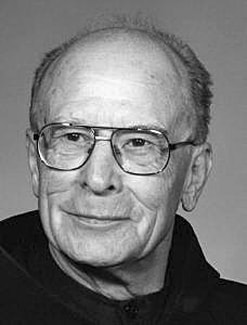 Fr. Ephrem Hertel
Fr. Ephrem Hertel
Fr. Ephrem Hertel was born in Chilton, WI on August 13, 1912. He was the sixth of twelve children. No one in the history of St. Joe's was ever at the parish rectory so continuously as Fr. Ephrem. In a word: he was available. He worked long hours. In fact, outside of sleeping and eating, that is about all he did.. work. He enjoyed listening to the Brewers or Packers, but he would be doing his book work. Fr. Roger Zach commented that he had never met a more organized person than Fr. Ephrem. Everything was in order. Precision should have been Fr. Ephrem's second name. He was never late for any service or appointment.
He not only knew the value of work, he knew the value of a dollar. Under his management, the Parish which was so heavily in debt, systematically and rather rapidly got its house in financial order. Perhaps his greatest accomplishment was getting the parish out of debt.
In all of his assignments, Ephrem never shied away from physically demanding work, whether it involved maintenance, building, landscaping or painting. A familiar sight in winter time saw Fr. Ephrem with his faithful snow plow.
In 1973, the Capuchins introduced the idea of "Co-Pastors" to the parish. Up until this time, there was only one person referred to as the "Pastor". Other priests were assigned to the parish, but they were referred to as "Assistants" or "Associates". Fr. Ephrem graciously finished his three year term as "Pastor" and then would continue on for five more years as a Co-Pastor" here, at St. Joe's.
He not only knew the value of work, he knew the value of a dollar. Under his management, the Parish which was so heavily in debt, systematically and rather rapidly got its house in financial order. Perhaps his greatest accomplishment was getting the parish out of debt.
In all of his assignments, Ephrem never shied away from physically demanding work, whether it involved maintenance, building, landscaping or painting. A familiar sight in winter time saw Fr. Ephrem with his faithful snow plow.
In 1973, the Capuchins introduced the idea of "Co-Pastors" to the parish. Up until this time, there was only one person referred to as the "Pastor". Other priests were assigned to the parish, but they were referred to as "Assistants" or "Associates". Fr. Ephrem graciously finished his three year term as "Pastor" and then would continue on for five more years as a Co-Pastor" here, at St. Joe's.
Past Co-Pastors # 28 - Fr. Ephrem Hertel & Fr. Roger Zach 1973-1975
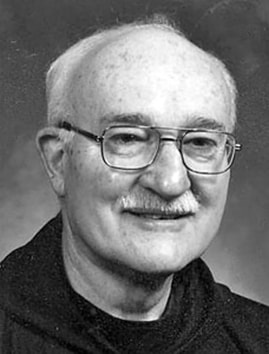 Fr. Roger Zach
Fr. Roger Zach
At the Capuchin Provincial Chapter of 1973, a new concept of "Team Ministry" was looked at and recommended for some parishes. The idea of "Co-Pastors" was suggested for St. Joe's. Up until this time, there was one Pastor with Assistant/ Associate Pastors. The difficulty with the co-pastor arrangement was, by church law, one of the men had to be named the canonical pastor. This created a situation where all things being equal, they really were not equal. Despite good intentions of the higher superiors, the co-pastor appointments ceased before the decade ended.
Since Fr. Ephrem had already been Pastor for three years, in practicality he was acting Pastor. His strengths have previously been documented.
Fr. Roger was born in Milwaukee on May 6, 1922. He came to St. Joe's after spending 28 years at St. Lawrence Seminary as a teacher and rector. It must have been quite a transition for him to leave the academic arena and begin parish ministry. While working with Fr. Ephrem, he was coordinator of the Social Action Committee, Parish and Family Life and Worship.
Roger was a healing magnet for people. He provided reassurance to those who were experiencing anxiety. He had a refreshing ability to help heal the hurts of others.
Since Fr. Ephrem had already been Pastor for three years, in practicality he was acting Pastor. His strengths have previously been documented.
Fr. Roger was born in Milwaukee on May 6, 1922. He came to St. Joe's after spending 28 years at St. Lawrence Seminary as a teacher and rector. It must have been quite a transition for him to leave the academic arena and begin parish ministry. While working with Fr. Ephrem, he was coordinator of the Social Action Committee, Parish and Family Life and Worship.
Roger was a healing magnet for people. He provided reassurance to those who were experiencing anxiety. He had a refreshing ability to help heal the hurts of others.
Past Co-Pastors # 29 - Fr. Roger Zach (1975-1984) & Fr. Campion Baer (1975-1978)
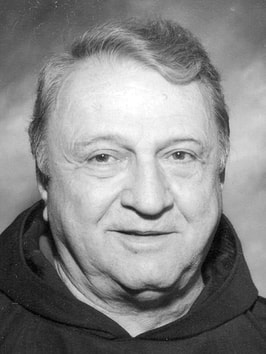 Fr. Campion Baer
Fr. Campion Baer
In 1975, our Co-Pastors were Fr. Roger Zach and Fr. Campion Baer. Interestingly, Fr. Ephrem continued to minister at St. Joe's but was now considered and Associate Pastor! Wonder how difficult that was for him?
Fr. Roger and Fr. Campion worked as Co-Pastors for three years. In 1978, Fr. Campion left St. Joe's and Fr. Roger became Pastor for another six years. So, the experiment of Co-Pastors lasted for only five years. It seems the concept of Co-Pastors was tried in many places bit didn't last much longer than it did here.
Fr. Campion did a great job here. He was a man of action, yet he weighted well any decision, especially if it meant spending money. His policy was to do it ourselves if it could be done, even if the job was not the most professional. His signs may have lacked artistic talent but they did get the event or occasion promoted.
Fr. Campion followed in the footsteps of Fr. Ephrem with his financial wisdom. He helped return the parish from the brink of financial disaster only ten years earlier to a very respected and solvent position.
It was in August, 1977 that St. Mary and St. Joseph Parishes began to discuss the idea of consolidating their two elementary schools. The plan was approved in April, 1978 under the name of "catholic Central" school. The two schools merged and opened for classes in 1979 at the State Street campus.
Fr. Campion supervised the changes in the church. During this period, the interior to the church was dedicated to Mary and the baptistery in the rear of the church was replaced. The stained glass window behind the latar was once again uncovered. It had been hidden since the turn of the century.
The old school was also demolished to make way for the new hotel and convention center. There was some thought given to a Parish Center being built just east of the Friary. That idea was put on hold at the time.
Fr. Roger, of course, was deeply involved in all of the above, too. And one of the highlights during his time as Pastor was the establishment of the renowned St. Joseph Food Program. It was begun in September, 1982.
The Parish Newsletter of February, 1984 had the following tribute to Fr. Roger as he left St. Joseph Parish: "It is with true sorrow that we say 'Good Bye' to you as you leave us to continue your education in the knowledge of God and His ministry. However, our sorrow at your leaving is tempered with our gratitude for the wonderful memories you have given us."
Fr. Roger and Fr. Campion worked as Co-Pastors for three years. In 1978, Fr. Campion left St. Joe's and Fr. Roger became Pastor for another six years. So, the experiment of Co-Pastors lasted for only five years. It seems the concept of Co-Pastors was tried in many places bit didn't last much longer than it did here.
Fr. Campion did a great job here. He was a man of action, yet he weighted well any decision, especially if it meant spending money. His policy was to do it ourselves if it could be done, even if the job was not the most professional. His signs may have lacked artistic talent but they did get the event or occasion promoted.
Fr. Campion followed in the footsteps of Fr. Ephrem with his financial wisdom. He helped return the parish from the brink of financial disaster only ten years earlier to a very respected and solvent position.
It was in August, 1977 that St. Mary and St. Joseph Parishes began to discuss the idea of consolidating their two elementary schools. The plan was approved in April, 1978 under the name of "catholic Central" school. The two schools merged and opened for classes in 1979 at the State Street campus.
Fr. Campion supervised the changes in the church. During this period, the interior to the church was dedicated to Mary and the baptistery in the rear of the church was replaced. The stained glass window behind the latar was once again uncovered. It had been hidden since the turn of the century.
The old school was also demolished to make way for the new hotel and convention center. There was some thought given to a Parish Center being built just east of the Friary. That idea was put on hold at the time.
Fr. Roger, of course, was deeply involved in all of the above, too. And one of the highlights during his time as Pastor was the establishment of the renowned St. Joseph Food Program. It was begun in September, 1982.
The Parish Newsletter of February, 1984 had the following tribute to Fr. Roger as he left St. Joseph Parish: "It is with true sorrow that we say 'Good Bye' to you as you leave us to continue your education in the knowledge of God and His ministry. However, our sorrow at your leaving is tempered with our gratitude for the wonderful memories you have given us."
Past Pastor # 30 - Fr. John Zickert
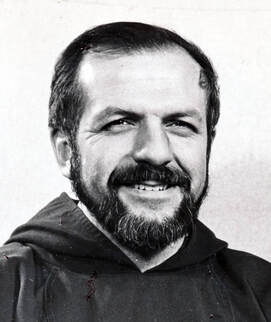 Fr. John Zickert
Fr. John Zickert
Born in Fond du Lac, WI on February 26, 1942, Fr. John Zickert became our 30th pastor at the age of 42. He was dedicated to serving the poor and those in need. He was instrumental in developing the current site of the St. Joseph Food Pantry. He joined his efforts to those of the COTS Housing Program, The Community Clothes Closet, Leaven, Beacon of Hope, and various other community service programs.
The St. Joe's renovation project (almost $400,000) was completed in early February, 1985. It included new offices and meeting rooms, the atrium connecting church and friary and renovated living quarters.
Fr. John was deeply involved in the formation of ACES (Appleton Catholic Education System). This was a long and continuous effort. Frank and heated discussions centered on locating the middle school either at St. Joe's or St. Therese's. Finally in 1987, after months of deliberation, the ACES board decided by one vote to locate the new ACES middle school at St. Joe's. ACES endured for twenty-five years.
Anticipating the 125th anniversary of St. Joseph Parish, Fr. John guided the parish in 1991 into a "Church Restoration" project. It involved adding the Great Hall with bathrooms and a kitchenette onto the west side of the church and renewing the interior of the church. The pews were taken out of the church so it could be painted (Mass was held in the school gym for at least 3 months). When the pews were re-installed, some were removed from the front and back of the church. The reredos was installed as well as the current altar platform. Our altar and pulpit were rebuilt as they are today. The baptismal font was made and placed in the back of church. Our current Bride's/Reconciliation Room and Vesting Sacristy were also installed at this time.
The crowning of this project was the celebration of the parish's 125th anniversary. On March 19, 1982, Bishop Banks came and celebrated a re-dedication Mass for the parish. Following the Mass, a parish dinner was held at the Paper Valley Hotel.
The St. Joe's renovation project (almost $400,000) was completed in early February, 1985. It included new offices and meeting rooms, the atrium connecting church and friary and renovated living quarters.
Fr. John was deeply involved in the formation of ACES (Appleton Catholic Education System). This was a long and continuous effort. Frank and heated discussions centered on locating the middle school either at St. Joe's or St. Therese's. Finally in 1987, after months of deliberation, the ACES board decided by one vote to locate the new ACES middle school at St. Joe's. ACES endured for twenty-five years.
Anticipating the 125th anniversary of St. Joseph Parish, Fr. John guided the parish in 1991 into a "Church Restoration" project. It involved adding the Great Hall with bathrooms and a kitchenette onto the west side of the church and renewing the interior of the church. The pews were taken out of the church so it could be painted (Mass was held in the school gym for at least 3 months). When the pews were re-installed, some were removed from the front and back of the church. The reredos was installed as well as the current altar platform. Our altar and pulpit were rebuilt as they are today. The baptismal font was made and placed in the back of church. Our current Bride's/Reconciliation Room and Vesting Sacristy were also installed at this time.
The crowning of this project was the celebration of the parish's 125th anniversary. On March 19, 1982, Bishop Banks came and celebrated a re-dedication Mass for the parish. Following the Mass, a parish dinner was held at the Paper Valley Hotel.
Past Pastor # 31 - Fr. John Holly (1993-2003)
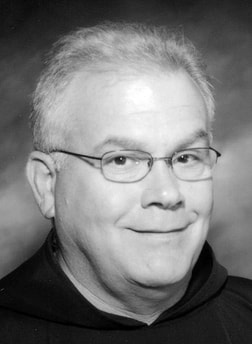 Fr. John Holly
Fr. John Holly
Fr. John Holly was born in Chicago, IL on August 26, 1953. He spent ten years as our 31st Pastor, which was about the longest stretch of any Pastor.
Early in 1995, the old convent (which was constructed in the 1920's and served as the home to the School Sisters of Notre Dame for 50 years) was turned into "Project Open Door". It took almost three years of planning and labor by the members of St. Joe's and other benefactors. It was an integral component of our parish's service to the homeless, especially families. Project Open Door had eight apartments for families in transition
On July 24, 1996, ground was broken for the new Midway Outreach Community which would house St. Joseph's Food Pantry. The pantry was begun in 1982 and was housed in our church basement and later in the school. Fr. John gave the invocation at the groundbreaking ceremonies.
The growth of the middle school brought challenges. In 2000, Fox Valley Lutheran High School announced it would be moving and asked if ACES would have interest in purchasing their Oneida Street campus. The coming together of this opportunity with the generosity of major donors enabled ACES to move to a facility that offered fantastic opportunities to ensure the future growth and excellence of Catholic education. In turn, St. Joe's was blessed to have a major offer to purchase the Lawrence St, Property for future development.
Surprisingly, the parish put together two pictorial directories during Fr. John's tenure. One was completed in 1996 and the other one in 2000. One item of controversy was the installation of addition organ pipes and console in the front of the church. When the school building was sold and demolished, there was need for meeting rooms and a religious education center. our inter-Parish Religious Formation program was jointly formed between St. Joe's and St. Mary's Parishes. The elementary classes were held at St. Mary's site and the high school students met at St. Joe's. Our need for a new building was addressed in 2002. The St. Joseph Parish Center Hall was completed, featuring 15 classrooms, Holly Hall, a reception area, and an elevator. Thanks be to God!
Early in 1995, the old convent (which was constructed in the 1920's and served as the home to the School Sisters of Notre Dame for 50 years) was turned into "Project Open Door". It took almost three years of planning and labor by the members of St. Joe's and other benefactors. It was an integral component of our parish's service to the homeless, especially families. Project Open Door had eight apartments for families in transition
On July 24, 1996, ground was broken for the new Midway Outreach Community which would house St. Joseph's Food Pantry. The pantry was begun in 1982 and was housed in our church basement and later in the school. Fr. John gave the invocation at the groundbreaking ceremonies.
The growth of the middle school brought challenges. In 2000, Fox Valley Lutheran High School announced it would be moving and asked if ACES would have interest in purchasing their Oneida Street campus. The coming together of this opportunity with the generosity of major donors enabled ACES to move to a facility that offered fantastic opportunities to ensure the future growth and excellence of Catholic education. In turn, St. Joe's was blessed to have a major offer to purchase the Lawrence St, Property for future development.
Surprisingly, the parish put together two pictorial directories during Fr. John's tenure. One was completed in 1996 and the other one in 2000. One item of controversy was the installation of addition organ pipes and console in the front of the church. When the school building was sold and demolished, there was need for meeting rooms and a religious education center. our inter-Parish Religious Formation program was jointly formed between St. Joe's and St. Mary's Parishes. The elementary classes were held at St. Mary's site and the high school students met at St. Joe's. Our need for a new building was addressed in 2002. The St. Joseph Parish Center Hall was completed, featuring 15 classrooms, Holly Hall, a reception area, and an elevator. Thanks be to God!
Past Pastor # 32 - Fr. Larry Abler (2003-2010)
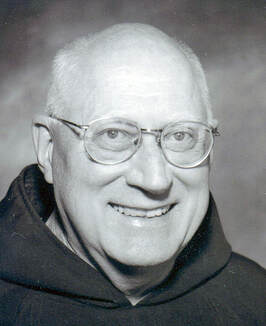 Fr. Larry Abler
Fr. Larry Abler
Our 32nd Pastor was born in St. Cloud, WI on August 4, 1938. When many people consider the invitations of retirement, Fr. Larry Abler (at age 65) said "yes" to continuing pastoral ministry here at St. Joe's. Parishioners knew of his arrival not just because of his enthusiasm, but especially because of his booming voice. His presence was easily known throughout the building.
One of his impressive accomplishments was establishing a warming shelter for the homeless of Appleton. In February of 2008, Fr. Larry organized volunteers to provide a hot meal each night in the Great Hall of St. Joseph. Bedding, pillows and sleeping mats were purchased. Vouchers were obtained for laundering items and clothing and bus passes were secured for those using the warming shelter who were working or looking for employment.
This continued till November when a "rotating shelter" began. Twenty churches opened their doors to provide a safe haven for the marginalized. Each week, the operation was moved from church to church. This plan continued to operate among the churches until a permanent shelter was finally built behind the St. Vincent de Paul Thrift Store on College Ave.
Another fine accomplishment was the creation of a pictorial directory in 2004. It has taken eleven years to replace it in 2015.
Perhaps the toughest challenge came towards the end of Fr. Larry's days here. In February, 2010, Fr. Michael O'Rourke, the longtime Pastor of nearby St. Mary's, died suddenly. It was a heartache for the parishioners of St. Mary's. Fr. Larry was able to help with the funeral and address the needs of the parish. While continuing as Pastor of St. Joe's, he was asked to "administer" St. Mary's for the next five months. From all accounts, he did remarkably well!
One of his impressive accomplishments was establishing a warming shelter for the homeless of Appleton. In February of 2008, Fr. Larry organized volunteers to provide a hot meal each night in the Great Hall of St. Joseph. Bedding, pillows and sleeping mats were purchased. Vouchers were obtained for laundering items and clothing and bus passes were secured for those using the warming shelter who were working or looking for employment.
This continued till November when a "rotating shelter" began. Twenty churches opened their doors to provide a safe haven for the marginalized. Each week, the operation was moved from church to church. This plan continued to operate among the churches until a permanent shelter was finally built behind the St. Vincent de Paul Thrift Store on College Ave.
Another fine accomplishment was the creation of a pictorial directory in 2004. It has taken eleven years to replace it in 2015.
Perhaps the toughest challenge came towards the end of Fr. Larry's days here. In February, 2010, Fr. Michael O'Rourke, the longtime Pastor of nearby St. Mary's, died suddenly. It was a heartache for the parishioners of St. Mary's. Fr. Larry was able to help with the funeral and address the needs of the parish. While continuing as Pastor of St. Joe's, he was asked to "administer" St. Mary's for the next five months. From all accounts, he did remarkably well!
Past Pastor # 33 - Fr. James Leary OFM Cap. (2010-2021)
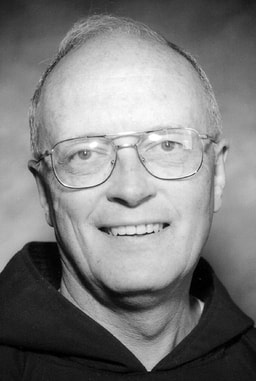 Fr. James Leary
Fr. James Leary
Fr. Jim Leary born in Stevens Point, WI September 3, 1944 and attended two years of high school at Pacelli Catholic High School. He then transferred to St. Lawrence High School Seminary in Mount Calvary, Wis., before entering the Capuchin novitiate at St. Felix Friary in Huntington, Ind. He was ordained to the priesthood on Sept. 3, 1970, at St. Lawrence Seminary. His first job was recruiting for St. Lawrence Seminary. He also worked for six years as director of the Capuchin Soup Kitchen in Detroit. Most of his ministry, however, has been as a pastor. He has also served at parishes in Detroit; St. Paul, Minn.; Billings, Mont.; and Sparta, Wis from 1999-2010.
He became the pastor of both St. Mary's and St. Joseph's Parishes, Appleton in 2010 until 2014.
In 2014, became pastor of St. Joseph Parish until his departure July 2021.
Accomplishments while at St. Joe's:
Burned the mortgage on Feb 17, 2013
Repaired Church Steeple (Fall, 2014)
Celebrated St. Joseph’s 150th Anniversary and Mass with Bishop Ricken (March 19, 2017)
Restored the Stained Glass Windows (2018-2019)
Installed Lights on the Steeple Tower Clocks (2019)
Successfully completed “one by One” Capital Campaign (2019 – 2020)
He became the pastor of both St. Mary's and St. Joseph's Parishes, Appleton in 2010 until 2014.
In 2014, became pastor of St. Joseph Parish until his departure July 2021.
Accomplishments while at St. Joe's:
Burned the mortgage on Feb 17, 2013
Repaired Church Steeple (Fall, 2014)
Celebrated St. Joseph’s 150th Anniversary and Mass with Bishop Ricken (March 19, 2017)
Restored the Stained Glass Windows (2018-2019)
Installed Lights on the Steeple Tower Clocks (2019)
Successfully completed “one by One” Capital Campaign (2019 – 2020)
Past Pastor #34 - Fr. Gerry Pehler, OFM Cap. (2021-2022)
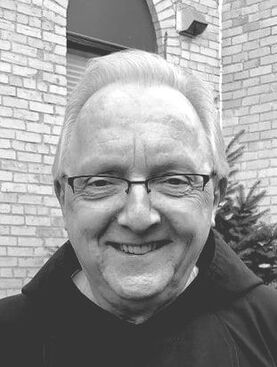 Fr. Gerry Pehler
Fr. Gerry Pehler
Fr. Gerry Pehler born in Arcadia, Wisconsin May 29, 1950.
Father Gerry joined the Capuchins in 1969 and was ordained a priest in 1988. Father Gerry has ministered as a pastor at parishes in Wisconsin, Indiana and Michigan, as well as serving in ministry at the Solanus Casey Center in Detroit. Father Gerry’s vocation to become a Capuchin began while attending Saint Lawrence Seminary High School in Mount Calvary, Wisconsin.
“It was only after joining the Capuchins, did I come to know and actualize my calling to religious life of what it meant to be a Franciscan, living out my vows in the spirit of Saint Francis of Assisi, and the Gospel way of life,” said Father Gerry. “Serving the needs of others in various roles and ministries has brought much joy and satisfaction to my life," said Father Gerry. “Being a Capuchin has always been about reassuring people that they are loved and cared for by God, and that compassion for people is truly a Franciscan charism.”
Fr. Gerry became the 34th Pastor of St. Joseph Parish on August 1, 2021.
Past Pastor #35 - Fr. Raja Selvam (2022-23)
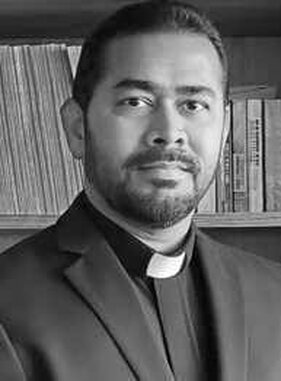 Fr. Raja Selvam
Fr. Raja Selvam
Fr. Raja Selvam was appointed as administrator of the parish in July 2022, and served for seven months until the appointment of a permanent pastor. Fr. Raja hails from the Catholic Diocese of Sivagangai, India. He was ordained on April 15th, 2007, and served in his home diocese for 3 years before traveling to the United States to pursue high education. During his time in the Archdiocese of Los Angeles – California, he earned two master’s degrees: one in Systematic Theology from Loyola Marymount University, Los Angeles and the other in Journalism from the University of California Los Angeles (UCLA). Fr. Raja previous served at the Green Bay diocese in Antigo, Howard, and Green Bay while he worked on his doctoral studies. He completed his thesis for his doctorate in Media Evangelization at Catholic Theological Union, Chicago while serving at St. Joseph Parish. After he completed his assignment at St. Joseph's, he served the parishes in Kaukauna before returning to India in May 2023 for a position in his home diocese.
Fr. Raja says of his time at St. Joe's: "I am very grateful to the Almighty for this wonderful opportunity to serve you. St. Joe’s taught me a lot and gave me numerous opportunities to learn many things for my personal and pastoral life, for which I am truly grateful."
